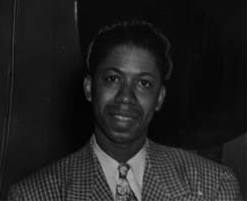
"I am an artist, not a flunky."
—Buster Bennett to Harold Lighfoot of the Tradesmen's Club, June 29, 1945 (cited in Musicians Union Local 208 Board meeting minutes, July 5, 1945, p. 3)
"Any orchestra can play to a full house on week ends, while Buster Bennett is the only one that can make the place do business every night."
—Matt Lightfoot, owner of the Tradesmen's Club, Musicians Union Local 208 Board meeting minutes, April 4, 1946 (pp. 3 - 4).
"Bennett is one of those guys you don't necessarily care to like but you end up, invariably, in his corner, every time ... he grows on you like an octopus ..."
—Bob Williams, "Bobbing Along," Cleveland Call and Post, August 6, 1949, p. 8B.
Revision note: We've updated our photos. All of Buster's own Columbia sides are now included, as are high-quality scans of Rhumboogie 5001 and Apollo 390 and Apollo 405). We have also supplied release dates from the trade papers for Buster's Columbias, and (amazingly) for the two Israel Crosby singles on Apollo. We have found a fifth Israel Crosby side, which (even more amazingly) was released in 1996—misattributed to a different artist on a different session. Our thanks to Konrad Nowakowski for photos of the flamingly rare Apollo 405 and for a complete update on the sesssion (despite one disagreement that will be explained below); to Dani Gugolz for a definite (and obviously correct) artist and session identification on the previously misattributed track.
James Joseph "Buster" Bennett was an interesting saxophonist and singer who has been almost completely disregarded. He also played piano and string bass professionally during his career. He arrived in Chicago in the summer of 1938; his last mention in the Chicago Defender came in April 1954. Buster appeared on 28 recording sessions between 1938 and 1947. His career on record divides neatly into two phases, though these are an artifact of the recording practices that prevailed among the major labels in Chicago. In the first part of his career he worked as a blues accompanist in the studios; during the second part, after being signed as a leader, he was presented as a gutbucket instrumentalist and blues singer. American Recording Company saw no point in preserving Robert Johnson's rendition of "My Blue Heaven"; we have just one side of Buster Bennett singing the standards that were his bread and butter in Chicago nightclubs. All that remains is the "Buster Bennett Medley."

Joseph Buster Bennett (as he was styled on his Social Security Application) was born in Pensacola, Florida, on March 19, 1914. His parents were James Bennett and Alice Wright Bennett; his full name at birth was probably James Joseph Bennett (as he was once called in the minutes of the Board meetings for Chicago Musicians Union Local 208). We know nothing about his early days. When he cut his first recordings in 1938, he was a highly distinctive, gutbucket stylist with many 1920s features still adhering to his playing (not least of them his continued use of the soprano sax, which was way out of fashion by this time). All of this suggests that he learned early and was playing profesionally in his teens.
We do have a statement by singer and bassist Edward "Duke" Groner indicating that Buster was already a touring musician around 1930. Groner, who worked in Buster's trio in Chicago in 1944 and 1945, told Charles Walton, "There were also a lot of people here in Chicago from Texas and I started working with... Buster Bennett. I met Buster in Texas sometime before my Wiley College days. Buster... Wild Bill Davis, piano... and myself, bass, worked together for a while." (The quotation is from the late Charles Walton's profile in his Bronzeville Conversations on the Jazz Insitute of Chicago website; Groner actually says that Buster played tenor sax at the time, but Buster did not record on that instrument until after Groner left his group.) Duke Groner attended Wiley College in Marshall, Texas. The exact dates are not clear, though Groner (born in 1908) played in the Wiley Collegians and stayed long enough to graduate, then (by his account) spent four years with Nat Towles, until Horace Henderson took over the Towles band. Since the Horace Henderson takeover took place in the fall of 1940, and Groner joined Towles in Dallas before Towles' band relocated to Omaha (i.e., sometime in 1935), Groner could have enrolled at Wiley in 1931. Still some details to nail down here.
Our very first written record of Buster Bennett, who by then was 24 years old and had been playing professionally for at least 8 years, is a one-paragraph blurb in the Chicago Defender, from July 9, 1938. Here we learn that the new Tuxedo Inn and Tavern was opening its beer garden for the summer. "Buster Bennett and his swing orchestra plays jazzy tunes for a snappy revue which is presented three times nightly" ("Tuxedo Inn Has a Snappy Revue," Chicago Defender, July 9, 1938, p. 19).
The second written record we have found is his Social Security application, which he filled out in Chicago on August 30, 1938. The Tuxedo gig must have been over by then. He was living at 2829 South Calumet Avenue, and gave his employer as the Works Progress Administration, a New Deal scheme to put the unemployed to work. (On his second recording session, just over two weeks later, he accompanied Big Bill Broonzy on a number titled "WPA Rag.")
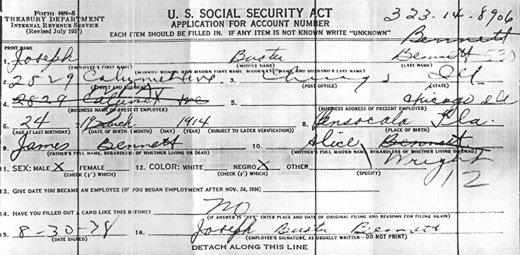
Buster Bennett got his start, recording-wise, on blues sessions for the Melrose combine, in September 1938. He would work the studios with Big Bill Broonzy, The Yas Yas Girl, and Monkey Joe; his most fruitful association seems to have been with Washboard Sam, who found his alto (or soprano) sax to be an ideal melody instrument. He also did two non-Melrose sessions with Jimmie Gordon, under the direction of Sammy Price. Ransom Knowling (bass player on many Melrose sessions) once told Bob Koester that Buster Bennett got on a lot of sessions because he was so adept at extracting advances on his salary from Walter Melrose, who would then have to schedule him for another session to recoup. Some documentary evidence supports this claim. As we will see, Buster was also in the habit of drawing advances from nightclub owners.
Although Buster played on such hits as "Diggin' My Potatoes," his claim to fame stems from his own three-year contract with Columbia, which ran from 1945 through the end of 1947 (he did one final session with Broonzy, just getting back into the studios after the 1942 recording ban, right before starting to record under his own leadership). On paper he might look like Louis Jordan, but the two had little in common besides leading a small combo, singing, and playing alto sax. Columbia wanted Buster to sing blues; he came across as more of a strict blues singer than Jordan, and a lot less polished vocally. Where Jordan was a consummate Swing player, Bennett's alto and soprano sax stylings (hardly anyone else was playing soprano in the late 1940s) were vigorous but had a quaint, almost 1920s tone and rhythmic feel. When Bennett employed front line partners (usually in the studio, not on the gigs he most often played with just sax, piano, and bass), he was careful to find complementary horn players who swung more and rocked less than he did. In 1946 and 1947, he made the (seemingly inevitable) R&B soloist's move to tenor sax. He hired beboppers to complete his front line, and started copping a few licks himself.
The end of Bennett's recording contract came with the general fall-off of blues recording in Chicago by the majors. Indeed, Columbia would shut down its 30000 "race" series in 1950. It would be interesting to know how Bennett's style evolved after the end of 1947. Despite an appearance on one of the first sessions for Aristocrat, he never caught on with Chess or the other independents that were taking over blues recording locally. Since Chess was willing to give his former employers Big Bill Broonzy and Washboard Sam a tryout, Buster's legendary temperament may have had something to do with that.
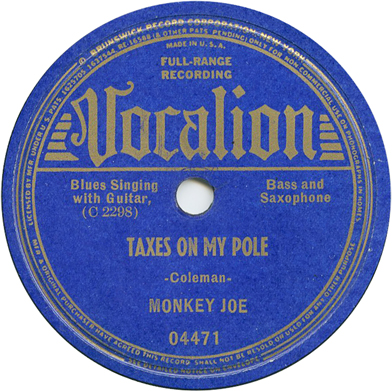
Jesse "Monkey Joe" Coleman (p, voc); Buster Bennett (as); Charlie McCoy (mandolin); unidentified (b).
Chicago, September 8, 1938
| C 2298-1 | Taxes on My Pole (Coleman) | Vocalion 04471, Conqueror 9163, Old Tramp OT 1208, Document DOCD 5412 | |
| C 2299-1 | Must I Break 'em on Down? | Vocalion 04416, Old Tramp OT 1208, Document DOCD 5412 | |
| C 2300-1 | Just out the Big House (Coleman) | Vocalion 04618, Document DOCD 5412 |
Vocalion 04416, 04471, and 04618 and Conqueror 9163 were singles released in 1938 and 1939. Document DOCD 5412 was issued in 1995 under the title Monkey Joe, Complete Recorded Works, Volume 1: 1935-1939. Session information from the liners to this CD. Document says that the bass player is present only on "Big House," but the string bass is clearly audible on all three titles! Information on the Old Tramp LP reissue is drawn from Görgen Antonsson's Prewar blues & gospel on microgroove (http://sunsite.kth.se/feastlib/mrf/yinyue/pw/INTRO.HTM).
Three more titles (C2301-2, 2302-1, and 2303-1) were recorded at this session without Bennett (McCoy seems to have switched to guitar on two of them); they formed the flip sides of the aforementioned Vocalion singles (and of Conqueror 9163, which was identical to Vocalion 04471).


Big Bill Broonzy (voc, g); Walter Williams (tp); Buster Bennett (as); Blind John Davis (p); prob. Ransom Knowling (b).
Chicago, September 15, 1938
| C2325-1 | WPA Rag (Broonzy) | Vocalion 04429, Conqueror 9164, Vinyl IRC I-02 [10" LP], Manhattan MAN-502, Columbia CK 46219, Columbia CK 46219 [CD], Columbia Roots n Blues CJ46219, Columbia Roots n Blues [J] CSCS5325, Columbia Roots n Blues 467247 [CD], Document DOCD 5129 | |
| C2326-1 | Going Back to Arkansas | Columbia Roots n Blues CK 46219, Columbia Roots n Blues CJ46219, Columbia Roots n Blues [J] CSCS5325, Columbia Roots n Blues 467247 [CD], Columbia Roots n Blues CK 46219 [CD], Document DOCD 5130 | |
| C2327-1 | Rider Rider Blues | Vocalion 04486, Conqueror 9165, Best of Blues BoB 2, Document DOCD 5130 |
Vocalion 04429 and 04486, along with Conqueror 9165, were 78-rpm singles released at the time. The LP-era reissues are mostly derived from Görgen Antonsson's Prewar blues & gospel on microgroove (http://sunsite.kth.se/feastlib/mrf/yinyue/pw/INTRO.HTM). Columbia CK 46219 was a CD in the Legacy series, released in 1990 under the title Big Bill Broonzy: Good Time Tonight; for a while, it had an LP counterpart. Dixon, Godrich, and Rye list several other incarnations of this package. Document DOCD 5129 was released in the early 1990s under the title Big Bill Broonzy, Volume 7. Document DOCD 5130 is titled Big Bill Broonzy, Volume 8 (1938-1939).
The notes to the Legacy CD identify the trumpet player as "Mr. Sheiks" and the bassist as Wilbur Ware (Ware was born September 8, 1923, so he would have just turned 15; surely he was playing well enough in 1938 to do the session, but he did not join Local 208 of the Musicians Union until 1946). The Legacy notes also mention an unidentified second guitarist. Michel Chaigne (email communication, September 11, 2006) points out that Big Bill says "Play Mr. John' on both C2326 and C2327, cementing the identification of Blind John Davis as the pianist.
According to Antonsson, four more titles (C2324, C2229, C2331, C2332) were recorded at this same session by Big Bill Broonzy (while the fate of C2328 and C2330 is unknown); accompaniment was by Blind John Davis (p) and an unidentified bassist.
Jimmy McLain (voc -1) or Minnie Mathes (voc -2) accompanied by Buster Bennett (as); prob. Charlie McCoy (mandolin); Willie Bee James (g); Ransom Knowling (b).
Chicago, September 19, 1938
| C2333-1 | Tailor Made Blues -1 | Vocalion 04444, Document DOCD 5354 | |
| C2334-1 | Keep Your Fly-Trap Closed -1 | Vocalion 04444, Document DOCD 5354 | |
| C2335-1 | Ball Game Blues -2 | Vocalion 04431, Document DLP 580, Document DOCD 5327 | |
| C2336-1 | Please Come Home Daddy, Blues -2 | Vocalion 04431, Document DLP 580, Document DOCD 5327 | |
| C2337-2 | Winding Daddy Come On -2 | unissued | |
| C2338-2 | Chicago Men Blues (Mathews) -2 | Travelin' Man TM 8811, Document DLP 580, Document DOCD 5327 |
Our information on this session is derived from Dixon, Godrich, and Rye, and from Görgen Antonsson's Prewar blues & gospel on microgroove (http://sunsite.kth.se/feastlib/mrf/yinyue/pw/INTRO.HTM). We learned of the Jimmy McLain sides from the Document reissue (which also includes Buster's sideman work with Ramona Hicks aka Lillie Mae Kirkman). Dixon, Godrich, and Rye have Edgar Saucier playing alto sax on the two McLain sides; the altoist sounds like Buster Bennett to us. DGR do have Buster on the Minnie Matthes sides (Document gives him a "probable"). We can upgrade Buster to a "definite": on "Chicago Men," Minnie Mathes introduces the second alto sax solo with "Oh send me now, Buster." (The copyright to "Chicago Men" belongs to "Matthews," so there is some question about the correct spelling of Minnie's last name.)
Vocalion 04431 and 04444 were 78-rpm singles released at the time. Travelin' Man TM 8811 and Document DLP 580 were LPs. Document DOCD 5327 is various-artists CD, released in 1995 under the title Blue Ladies 1934-1941. The other artists are super-obscure female singers recorded by the Melrose combine: Irene Sanders, Stella Johnson, Lorraine Walton, Hattie Bolten, and Kansas Katie (real name Ethel King). Document DOCD 5354 is another various-artists compilation released in 1995 as Swingin' the Blues 1931-1939.
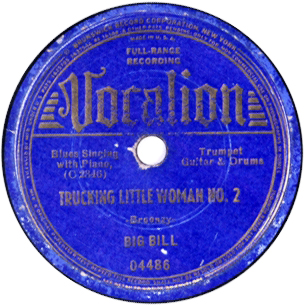
Big Bill [Broonzy] (voc, g); Buster Bennett (as); Blind John Davis (p); prob. Fred Williams (d).
Chicago, September 27, 1938
| C 2346-1 | Trucking Little Woman No. 2 (Broonzy) | Vocalion 04486, Conqueror 9165, Old Tramp OT 1220, Document DOCD 5130 |
Our information is from the leaflet to Document DOCD 5130, Big Bill Broonzy, Volume 8 (1938-1939). Vocalion 04486 and Conqueror 9165 were 78 rpm singles released at the time. The LP issue on Old Tramp is derived from Görgen Antonsson's Prewar blues & gospel on microgroove (http://sunsite.kth.se/feastlib/mrf/yinyue/pw/INTRO.HTM). Document gives Buster a "probable" here but we can upgrade him. Michel Chaigne points out that the pianist here is Blind John Davis, not Horace Malcolm as Document suggested.
C2345, from this same session, was made with Walter Williams on trumpet but without Buster; the lineup cited on the label to Vocalion 04486 really belongs to C 2345 (which, because of its lyrics, was not released till 1946).
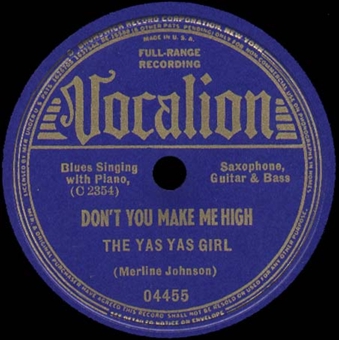
Merline Johnson aka The Yas Yas Girl (voc); Buster Bennett (ss); Blind John Davis (p); Willie Bee James (g -1); unidentified (b).
Columbia Studios, Chicago, October 4, 1938
| C2354-1 | Don't You Make Me High ("Johnson") | Vocalion 04455, Conqueror 9147, Earl BD-601, Stash ST 101, Document DOCD 5293 | |
| C2355-1,2 | Love with a Feeling (Whittaker) -1 | Vocalion 04455, Conqueror 9147, Earl BD-601, Document DOCD 5293 |
The session information is from Lord. However, Michel Chaigne (email communication, September 11, 2006) identifies the guitarist as Willie Bee James, not Big Bill. We are not sure which of the two takes of C2355 was used on the various issues.
Vocalion 04455 and Conqueror 9147 (this latter not mentioned by Lord) were 78-rpm singles released at the time. Earl BD-601 and Stash ST 101 were LP reissues; see Görgen Antonsson's Prewar blues & gospel on microgroove (http://sunsite.kth.se/feastlib/mrf/yinyue/pw/INTRO.HTM). Document DOCD 5293 is a 1995 release titled The Yas Yas Girl, Complete Recorded Works, Volume 2: 1938-1939.
"Don't You Make Me High" (first performed by Blue Lu Barker) is the song repopularized in the 1970s by Maria Muldaur. The original Vocalion label to "Love with a Feeling" incorrectly identifies Buster's instrument as a clarinet.
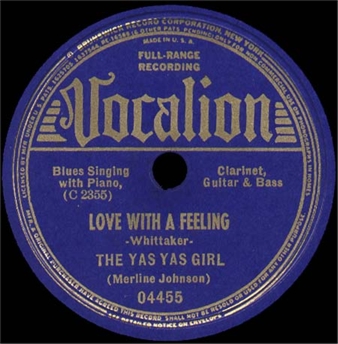
Mattie Hardy (voc) with prob. Charlie Idsen (tp); Buster Bennett (as); unidentified (ts); prob. Black Bob (p); prob. Joe McCoy (g); unidentified (b).Chicago, November 2, 1938
| C2377-1 | You Tore Up My Heart | Document DOCD-5354 | |
| C2378-1 | Vocalion (unissued) | ||
| C2378-2 | — | ||
| C2379-1 | You're All Right with Me | Document DOCD-5354 | |
| C2389-1 | He's Gone Away | Document DOCD-5354 |
This session was brought to our attention by Michel Chaigne and J. C. Hillman; we had previously overlooked it because the horns are most often just riffing in the background on these sides, and there are no long solos for the altoist. The only two sides that Vocalion released from it, C2374 and C2375, featured Mattie Hardy with the rhythm section only. The sides with the three horns survive today because Robert Altschuler was able to make vinyl test pressings of them in the 1960s. C2378 has never even been included in a Document release, though Chaigne owns a copy of take 1. The others appeared on Document DOCD 5354, Swingin' the Blues 1931-1939, in 1995.
According to Chaigne and Hillman, "Joe Williams" (no connection with the 9-string guitar player, or any other Joe Williams of importance in the blues world) was a pseudonym employed for Joe McCoy of the Harlem Hamfats, and the session a trial balloon for the group, which would soon switch label affiliations from Decca to Vocalion. The trumpet player and the tenor saxophonist would record with the Hamfats in 1939. The clearest evidence of Buster's involvement is a short solo after the second vocal chorus on "You're All Right with Me," an uptempo number that also features a short solo by the tenorist.


The Yas Yas Girl [Merline Johnson] (voc); Walter Williams (tp); Buster Bennett (as); Blind John Davis (p); Willie Bee James (g); prob. Ransom Knowling (b -1).
Chicago, February 10, 1939
| C 2488-1 | Breakin' 'em Down Tonight (unknown) -1 | Vocalion 04719, Conqueror 9205, Document DLP 562, Collector's Items 022, Document DOCD 5293 | |
| C 2489-1 | Someone to Take Your Place | Vocalion 04885, Collector's Items 022, Document DOCD 5293 | |
| C 2490-1 | Got a Mind to Ramble -1 | Vocalion 04885, Collector's Items 022, Document DOCD 5293 | |
| C 2491-1 | True Love -1 | Vocalion 04775, Collector's Items 022, Document DOCD 5293 |
Our session information is from Tom Lord's Jazz Discography. Conqueror 9205 (not mentioned in Lord), Vocalion 04719, Vocalion 04775, and Vocalion 04885 were 78-rpm singles issued at the time.
We filled in Williams and Knowling from the items by Big Bill and his Memphis Five, which were cut the same day, immediately after these; the Document liner notes agree with us on these, but give Bill Settles and not Ransom Knowling as the bassist. According to Michael Chaigne, the guitarist is Willie Bee James, not Big Bill as given in Lord.
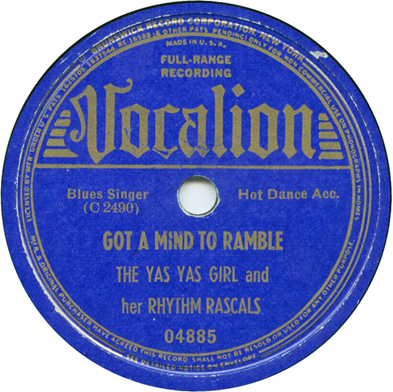
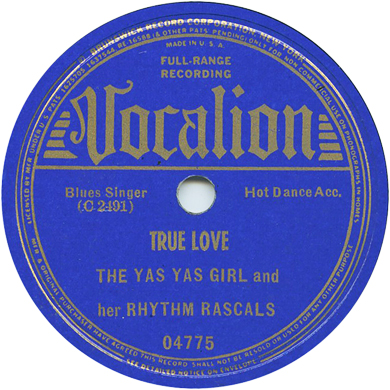
Our source for the LP reissues is Görgen Antonsson's Prewar blues & gospel on microgroove (http://sunsite.kth.se/feastlib/mrf/yinyue/pw/INTRO.HTM). Collector's Items 022 was a British LP from the early 1980s titled Mellow Rhythm; besides four titles from this session by The Yas Yas Girl, it also included tracks by The Melrose Stompers and by Sammy Butler and His Night Owls (our thanks to John Holley, proprietor of Collector's Items, for details). Document DOCD 5293, The Yas Yas Girl Volume 2 (1938-1939)is a CD from 1995.
The first four items from this session (C2484-1 through C2487-1) included the singer, piano, guitar, and bass only, hence are not listed here.
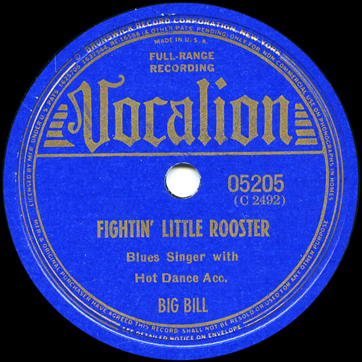
Big Bill [Broonzy] (voc, g); Walter Williams (tp); Buster Bennett (as); Blind John Davis (p); prob. Ransom Knowling (b).
Chicago, February 10, 1939
| C2492-1 | Fightin' Little Rooster ^ | Vocalion 05205, Conqueror 9342, Columbia 37787, Columbia 30089, KOB [B], RST BD-2012, Document DOCD 5130 | |
| C2493-1 | Mary Blues | Vocalion 04760, Conqueror 9278, RST BD-2096, Document DOCD 5130 | |
| C2494-1 | You Can't Sell 'em in Here | Vocalion 04829, Conqueror 9284, Document DLP 581, Document DOCD 5130 | |
| C2495-1 | Just Got to Hold You Tight | Document DOCD 5130 | |
| C2495-2 | Just Got to Hold You Tight | Vocalion 04760, Conqueror 9278, RST BD-2096, Document DOCD 5130 |
Basic information from the leaflet to Document DOCD 5130, Big Bill Broonzy, Volume 8 (1938-1939). Vocalion 04760, 04829, and 05205, along with their cognates Conqueror 9278, 9284, and 9342 were 78-rpm singles released at the time. Columbia 37787 was a 78-rpm reissue from 1947; Columbia 30089 was its counterpart in the label's "race" series. The LP-era reissues are derived from Görgen Antonsson's Prewar blues & gospel on microgroove (http://sunsite.kth.se/feastlib/mrf/yinyue/pw/INTRO.HTM). KOB was apparently an LP reissue without an issue number.
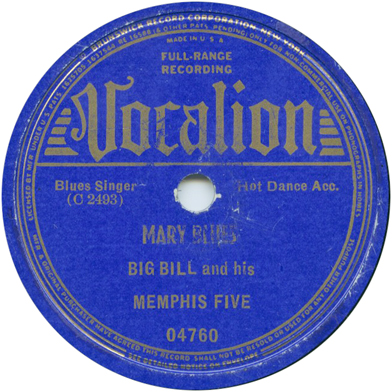
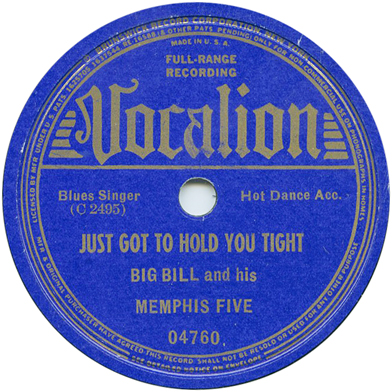
An ad in the Chicago Defender of March 18, 1939 mentions Buster Bennett playing at The Transfer Inn, 485 East 31st Street: "Featuring Buster Bennett, Horace Malkin [Malcolm?], P.C. Williams in the band."
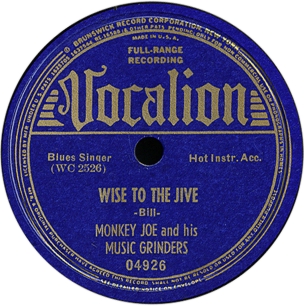
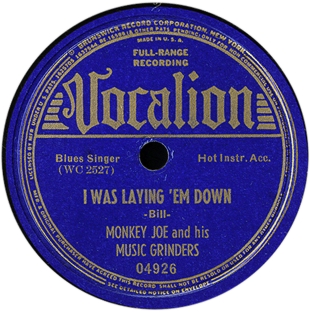
Jesse "Monkey Joe" Coleman (voc); Buster Bennett (as); Blind John Davis (p); Willie Bee James (g); Fred Williams (d).
Chicago, March 31, 1939
| WC 2526-A | Wise to the Jive (Broonzy) | Vocalion 04926-1, Document DOCD 5412 | |
| WC 2527-A | I Was Laying 'em Down (Brooozy) | Vocalion 04926-2, Old Tramp OT 1208, Document DOCD 5412 | |
| WC 2528-A | Tailor Made Woman (unknown) | Vocalion 04814, Old Tramp OT 1208, Document DOCD 5412 | |
| WC 2529-A | Trouble Comin' On (unknown) | Vocalion 04814, Old Tramp OT 1208, Document DOCD 5412 | |
| WC 2530-A | Good Business No. 2 | Vocalion 04871, Conqueror 9286, Document DOCD 5412 | |
| WC 2531-A | Mobile and K.C. Line | Vocalion 04978, Old Tramp OT 1208, Document DOCD 5413 | |
| WC 2532-A | B.V.D. Blues | Vocalion 04871, Conqueror 9286, Document DOCD 5413 | |
| WC 2533-A | Headache Blues | Document DOCD 5413 |

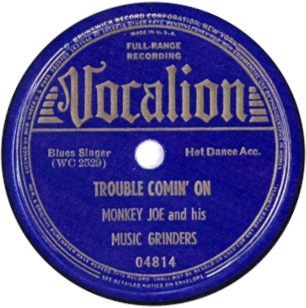
Discographical details of this session are from Dixon, Godrich, and Rye, and from the Document notes, which identify the guitarist and drummer. We might note that even though Document's annotators believe that Willie Bee James is on guitar, not Big Bill Broonzy, Big Bill gets does get credit on both sides of Vocalion 04926. Note also that 04926, unusually for a Vocalion, has side designations stamped into the margin of the label areas.
Document has Bennett playing alto and tenor sax. During this period, Buster was fond of starting solos with a long growl in his lower register—Monkey Joe seems to have liked this, judging from his shouts of encouragement. A casual listener might think the growl was coming from (a rather thin-toned) tenor sax. However, by the end of the solo, the growl would be off and the alto timbre unmistakable. On some numbers from this and the next Monkey Joe session, Buster also accompanies with low grunts on his instrument... Buster did not use the tenor sax on a recording until the "Charles Gray" session for Rhumboogie, in early 1946.
Our source for the LP reissue on Old Tramp is Görgen Antonsson's Prewar blues & gospel on microgroove (http://sunsite.kth.se/feastlib/mrf/yinyue/pw/INTRO.HTM).
The last three tracks from this session were reissued in 1995 on Document DOCD 5413, Monkey Joe Volume 2 (1939-1940) with Roosevelt Scott.
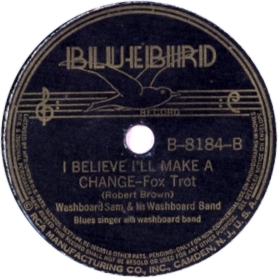
Washboard Sam [Robert Brown] (wbd, voc); Buster Bennett (as); prob. Joshua Altheimer (p); Big Bill Broonzy (g); prob. Ransom Knowling (b).
Chicago, May 15, 1939
| 034795 | I Believe I'll Make a Change (Brown) | Bluebird B-8184-B, Montgomery Ward M8570, Best of Blues BoB 1, Document DOCD 5174 | |
| 034796 | Wasn't He Bad (Brown) | Bluebird B-8270-A, Montgomery Ward M8573, RST [Au] BD-2091, RCA [Fr] 86.369 [EP], Document DOCD 5174 | |
| 034797 | Diggin' My Potatoes (Brown) | Bluebird B-8211-A, Montgomery Ward M8571, Victor 20-2162, Blues Classics BC 10, Document DOCD 5174 | |
| 034798 | I Love My Baby | Bluebird B8243, Montgomery Ward M8572, RST [Au] BD-2091, RCA [Fr] 130.256, Bella Musica [It] 3023, Document DOCD 5174 | |
| 034799 | That Will Get It | Bluebird B-8184-A, Montgomery Ward M8570, Best of Blues BoB 1, Document DOCD 5174 |
Basic information comes from the liners to Document DOCD 5174, a CD issued in 1993 under the title Washboard Sam: Volume 4 (1939-1940). The Bluebird and Montgomery Ward issues (licensed from Victor and sold in Montgomery Ward department stores) were 78-rpm singles released at the tiem. "Diggin' My Potatoes" was reissued on a 78 by RCA Victor in 1947. The LP-era reissues are derived from Görgen Antonsson's Prewar blues & gospel on microgroove (http://sunsite.kth.se/feastlib/mrf/yinyue/pw/INTRO.HTM). Blues Classics BC 10 was a Washboard Sam LP released in the 1960s. Best of Blues BoB 1 is an LP from the 1980s, as is RST BD-2091. Regarding French RCA 130.256, an LP from the 1970s, Antonsson notes that the LP claims to include "Diggin' My Potatoes" (matrix 034797) but actually plays "I Love You Baby" (034798). Three additional tracks from this session (034792, 034793, and 034794) are by Washboard Sam and rhythm only.
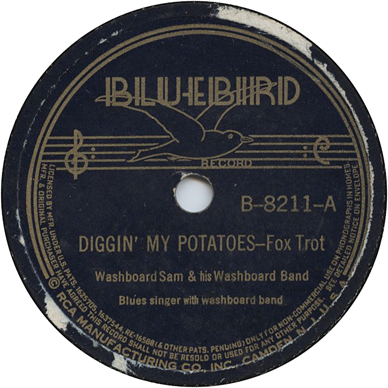
This was a busy day for Buster; he stuck around for the next session.
Ramona Hicks [Lillie Mae Kirkman] (voc); Joseph "Buster" Bennett (as); Aletha Robinson [Aletha Dickerson] (p); Leroy Brown (b); Jimmy Adams (vib -1); Reavely Randall (voc -2)
Chicago, May 15, 1939
| 034800-1 | I Must Have It | Bluebird B8173, Montgomery Ward M8562, RST BD-2077, Document DOCD 5354 | |
| 034801-1 | Ramona Blues -1 | Bluebird B8173, Montgomery Ward M8562, RST BD-2077, Document DOCD 5354 | |
| 034802-1 | Where the Eagle Builds His Nest -1 | Bluebird B8200, Montgomery Ward M8563, RST BD-2077, Document DOCD 5354 | |
| 034803-1 | Evil and Blue -1 | Bluebird B8233, Montgomery Ward M8564, RST BD-2077, Document DOCD 5354 | |
| 034804-1 | Don't Be like Me -1 | Bluebird B8233, Montgomery Ward M8564, RST BD-2077, Document DOCD 5354 | |
| 034805-1 | Tell My Mama on You -1, 2 | Bluebird B8200, Montgomery Ward M8563, RST BD-2077, Document DOCD 5354 |
Our information about this session comes from Dixon, Godrich, and Rye. Bluebird B8173, B8200, and B8233 were 78-rpm singles released at the time. The Montgomery Ward releases were also singles, licensed from Bluebird and sold exclusively in the then-prominent department store chain. The 1980s reissue on an RST LP, BD-2077, is derived from Görgen Antonsson's Prewar blues & gospel on microgroove (http://sunsite.kth.se/feastlib/mrf/yinyue/pw/INTRO.HTM). The entire session has reappeared on Document DOCD 5354, Swingin' the Blues (1931-1939), which was released in 1995. Thanks to Howard Rye for updates about the various issues.
Buster is featured prominently on these sides, beginning with his solo on "I Must Have It."
A Chicago Defender article from June 17, 1939 refers to Ramona Hicks, originally from St. Louis, "who is also known as Lillie Mae Kirk." Having compared the six Hicks tracks to "He's Just My Size," one of five sides cut by Lillie Mae Kirkman for Vocalion with a different band two months later, we've concluded that they're the work of the same singer, who was aligned with the Victoria Spivey axis. (According to Godrich, Dixon, and Rye, there is another, never issued cut from the Vocalion session credited in recording company files to "Randall and Randall"—note Ramona Hicks' vocal duet with Reavely Randall...) The "Ramona Hicks" sides have jazz and pop elements (reinforced by Aletha Dickerson's fluent pianism in the Fats Waller style) that are absent from the strictly blues-oriented Vocalion session. Lillie Mae Kirkman sang frequently in Chicago clubs during this period. After World War II, she would make one last appearance as just plain "Lillie Mae" on two sides done for Miracle in December 1947, accompanied by Memphis Slim and his House Rockers. See our Miracle page for a capsule biography.
We formerly listed Merline Johnson's session of August 31, 1939, which produced 9 tracks for Vocalion, in this discography. However, Michel Chaigne and J. C. Hillman convinced us that the alto saxophonist on these sides is Edgar Saucier and not Buster Bennett. The session has therefore been exiled to an appendix.

Jesse "Monkey Joe" Coleman (voc, p); Buster Bennett (as); Big Bill Broonzy (g); Alfred Elkins (jug).
Chicago, September 13, 1939
| WC-2702-A | You Don't Have to Tell Me | Vocalion 05274, Document DOCD 5413 | |
| WC-2703-A | Carry My Business On (Coleman) | Vocalion 05166, Old Tramp OT 1208, Document DOCD 5413 | |
| WC-2704-A | Mountain Baby Blues | Vocalion 05348, Old Tramp OT 1208, Document DOCD 5413 | |
| WC-2705-A | Just Give Some Away (Coleman) | Vocalion 05166, Old Tramp OT 1208, Document DOCD 5413 | |
| WC-2706-A | Bad Luck Man Blues | OKeh 05685, Document DOCD 5413 | |
| WC-2707-A | Bitin' on Me | Vocalion 05348, Old Tramp OT 1208,Document DOCD 5413 | |
| WC-2708-A | Old Man Blues | OKeh 06153, Old Tramp OT 1208, Document DOCD 5413 | |
| WC-2709-A | McComb City Blues | OKeh 06153, Old Tramp OT 1208, Document DOCD 5413 | |
| WC-2710-A | That Same Cat | Vocalion 05274, Document DOCD 5413 | |
| WC-2711-A | We Can't Get Along | OKeh 05685, Document DOCD 5413 |
Basic inormation from Godrich and Dixon, who put Willie Bee James on guitar and rate Bennett as "possible." This session was reissued in 1995 on Document DOCD 5413, Monkey Joe Volume 2 (1939-1940) with Roosevelt Scott. The Document notes hedge on the guitarist, but note that he sounds like Big Bill Broonzy and not like Willie Bee James—which seems correct. The Document notes point out that Elkins was singing imitation string bass notes while blowing on a jug (!), and upgrade Buster to definite. Document has Buster playing alto and tenor sax, but only alto is audible on these tracks.
Our information on the Old Tramp LP reissue is taken from Görgen Antonsson's Prewar blues & gospel on microgroove (http://sunsite.kth.se/feastlib/mrf/yinyue/pw/INTRO.HTM).
The confusion over the guitarist arouse because this session continued (WC-2712 through WC-2715) with Roosevelt Scott, who was accompanied by Monkey Joe and rhythm only. Scott told an interview that Big Bill was not on the session. Scott's memory may have been faulty—or they may have switched guitarists when his part of the session came up.
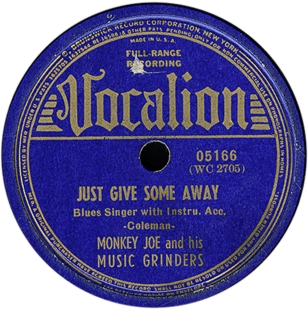
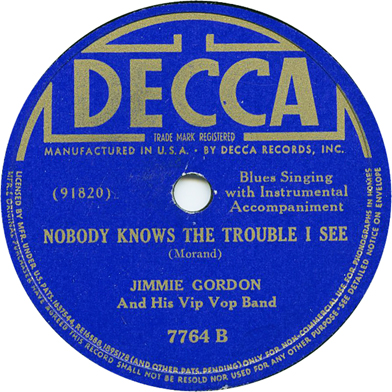
Jimmie Gordon (voc); Buster Bennett (as); Sam Price (p); poss. Ike Perkins (eg); Sid Catlett (d).
Chicago, September 29, 1939
| 91820-A | Nobody Knows the Trouble I See (Morand) | Decca 7764 B, RST BD-2075, Story of Blues 3510 [CD], Document DOCD 5650 | |
| 91821-A | The Boogie Man (Price) | Decca 7661 A, Document DLP 515, Story of Blues 3518 [CD], Document DOCD 5650 | |
| 91822-A | Ease It to Me (Lem Fowler) | Decca 7661 B, RST BD-2075, Story of Blues 3510 [CD], Document DOCD 5650 | |
| 91823-A | Henpecked Man (Carter) | Decca 7702 A, RST BD-2075, Story of Blues 3510 [CD], Document DOCD 5650 |
Date from the liners to Jimmie Gordon 1934-1941, a CD issued in 1989 on Story of Blues 3510. The liners give Sammy Price as the pianist and claim that the altoist is "probably Buster Bennett or possibly Pete Brown." One listen and it's clear that Buster is the man. Other information from Tom Lord's Jazz Discography.. Story of Blues 3518 is a CD titled The Mississippi Mudder: Jimmie Gordon 1934-1941, Volume 2. Story of Blues 3518 is a straight reissue of Document DLP 515. Document DOCD 5650, Jimmie Gordon Vol. III: 1939-1946, was issued in 1999; it appears to be a straight reissue of the LP RST BD-2075 (thanks to Görgen Antonsson's Prewar blues & gospel on microgroove (http://sunsite.kth.se/feastlib/mrf/yinyue/pw/INTRO.HTM for this listing). Howard Rye for updated us on reissues from the Vip Vop sessions.
According to Rye, "the daft suggestion of Pete Brown for [this session] goes back to Jazz Directory and is the result of illegitimate copying guesswork from a collective personnel in Index to Jazz." We previously listed the guitarist and drummer as unidentified, but Rye further explains that "Bob Weir's discography in Sammy Price's autobiography gives Sid Catlett, drums, and possibly Ike Perkins, g for 29 September 1939 (cf. the following Gene Gilmore and James Carter sessions on 91824 thru 91827). We followed this for Blues & Gospel Records, but hard evidence is not known to me."
A photo in the October 7, 1939 issue of the Defender is captioned "Entertainers at Manchester Tavern." It shows a "quartet of swingsters," Edward DuVernay and his band, who were working the weekends at the time. DuVernay is at the drums, Buster is on alto sax, Willie Thomas is at the piano (shown in profile, as the pianist sits with his back to the audience), and Woodrow Charles is on tenor sax. The proprietor, Cyril Richards, is also visible, standing in front of the small stage.
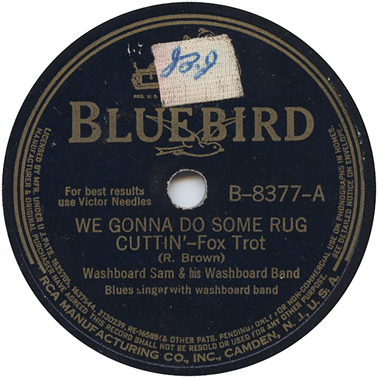

At his next session with Washboard Sam, Buster even managed to get his name on the label. Buster and Sam did a duet on "Block and Tackle," which is also the only recorded example of Buster playing piano.
Washboard Sam (speech -1; wbd, voc); Buster Bennett (speech, p -1; as); Horace Malcolm (p); Big Bill Broonzy (g).
Chicago, November 7, 1939
| 044068 | Has My Gal Been By Here? (Brown) | Bluebird B8323-A, Montgomery Ward M8798, Document DOCD 5174 | |
| 044069 | Somebody Changed That Lock on My Door (Brown) | Bluebird B8323-B, Montgomery Ward M8798, Document DLP 507, Document DOCD 5174 | |
| 044070 | Don't Fool with Me (Brown) | Bluebird B-8342-B, Montgomery Ward M8799, Best of Blues BoB 1, Document DOCD 5174 | |
| 044071 | Jersey Cow Blues (Brown) | Bluebird B-8342-A, Montgomery Ward M8799, Best of Blues BoB 1, Document DOCD 5174 | |
| 044072 | So Early in the Morning (Brown) | Bluebird B8358-A, Montgomery Ward M8800, Best of Blues BoB 1, Document DOCD 5174 | |
| 044073 | Beauty Spot (Brown) | Bluebird B8377-B, Montgomery Ward M8801, Document DOCD 5174 | |
| 044074 | We Gonna Do Some Rug Cuttin' (Brown) [ens voc] | Bluebird B8377-A, Montgomery Ward M8801, Document DOCD 5174 | |
| 044075-1 | Block and Tackle (Brown) -1 ^ | Bluebird B8358-B, Montgomery Ward M8800, RCA [Fr] FXM1 7297, Swingtime BT 2012, RCA [Fr] 130.256, Document DOCD 5174 |
Our main source for this session is Robert M. W. Dixon, John Godrich, and Howard Rye, Blues and Gospel Records 1890-1943, Oxford University Press (1997). The Bluebird releases (and their licensed counterparts on Montgomery Ward) were 78-rpm singles released at the time. See also the liner notes to Document DOCD 5174, Washboard Sam: Volume 4 (1939-1940). This session marks the first time that Buster's voice is heard on a record; besides his contribution to the dialogue on "Block and Tackle" (the title commemorates a variety of moonshine whiskey) he participates in the ensemble vocal on "We Gonna Do Some Rug Cuttin'".
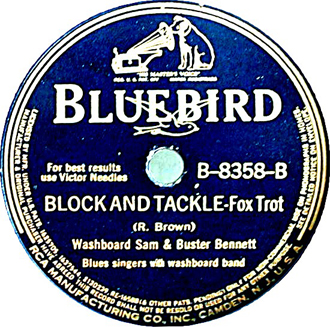
The LP-era reissues are derived from Görgen Antonsson's Prewar blues & gospel on microgroove (http://sunsite.kth.se/feastlib/mrf/yinyue/pw/INTRO.HTM).
Washboard Sam (wbd, voc); Buster Bennett (ss); Horace Malcolm (p); Big Bill Broonzy (g).
Chicago, March 22, 1940
| 049035 | Going Back to Arkansas (Brown) | Bluebird B8424-A, Montgomery Ward M8802, Document DOCD 5174 | |
| 049036 | Louise (Brown) | Bluebird B-8469-A, Montgomery Ward M8804, Document DOCD 5174 | |
| 049037 | I Won't Be Sober Long | Bluebird B8424-B, Montgomery Ward M8802, Document DOCD 5174 | |
| 049038 | Oh Babe (Joe McCoy) | Bluebird B-8469-B, Montgomery Ward M8804, Document DOCD 5174 |
Information from the liner notes to Document DOCD 5174, Washboard Sam: Volume 4 (1939-1940) and from Dixon, Godrich, and Rye. DGR and Document give Bennett a mere "probable," but we can do better than that. Document has Bennett playing soprano sax only on "Oh Babe," and DGR have him on alto throughout—in fact he plays soprano on all 4 cuts on which he is present. The Bluebird and their licensed counterparts, the Montgomery Wards, were 78-rpm singles released at the time. None of these sides were reissued on LP. Four additional tracks (049039 through 049042), two of which did see LP reissue, were cut at this session by Washboard Sam with piano and guitar only.
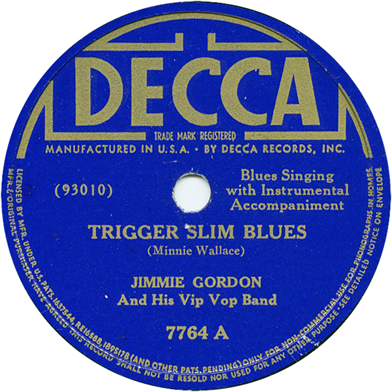
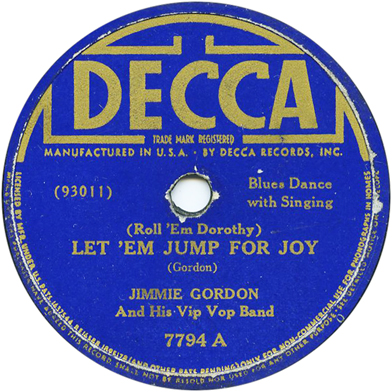
Jimmie Gordon (voc); Buster Bennett (as); Sam Price (p); unidentified (g); unidentified (b).
Chicago, June 4, 1940
| 93010-A | Trigger Slim Blues (Wallace) | Decca 7664 A, Document DLP 515, Story of Blues 3518 [CD], Document DOCD 5650 | |
| 93011-A | (Roll 'em Dorothy) Let 'em Jump for Joy (Gordon) | Decca 7794 A, Document DLP 515, Story of Blues 3518 [CD], Document DOCD 5650 | |
| 93012-B | L & N Blues (Fowler) | Decca 7794 B, RST BD-2075, Story of Blues 3510 [CD], Document DOCD 5650 |
Information from Lord. Story of Blues 3510 was issued in 1989 under the title Jimmie Gordon 1934-1941. Story of Blues 3518 is titled The Mississippi Mudder: Jimmie Gordon 1934-1941, Volume 2. Bennett is rated probable by Lord and possible by Document, but he is obviously present on "L&N Blues"; Price is rated probable by Lord. Document DLP 515 was an LP; Story of Blues 3518 reissues it in its entirety. Story of Blues 3510 appears to be a straight reissue of the LP RST BD-2075. Document DOCD 5650, Jimmie Gordon Vol. III: 1939-1946, was issued in 1999. Thanks to Howard Rye for updating us on reissues from the Vip Vop sessions.
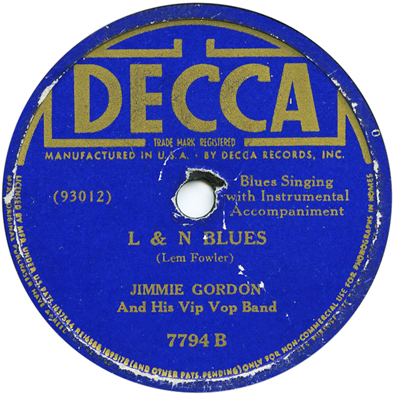
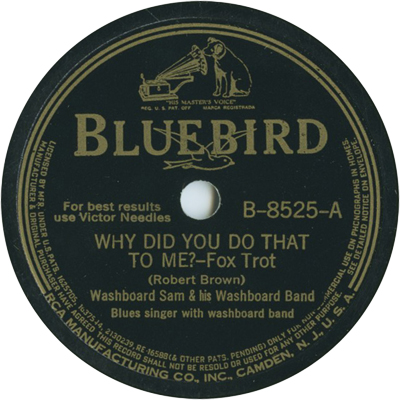
Washboard Sam (wbd, voc); Buster Bennett (as); prob. Joshua Altheimer (p); Big Bill Broonzy (g); unidentified (broom and pail bass).
Chicago, July 29, 1940
| 049340 | Why Did You Do That to Me? (Brown) | Bluebird B8525-A, Montgomery Ward M8928, Document DOCD 5175 | |
| 049341 | Digging My Potatoes - No. 2 | Bluebird B8554, Montgomery Ward M8930, Best of Blues BoB 1, Document DOCD 5175 | |
| 049342 | Chiselin' Blues (Brown) | Bluebird B8525-B, Montgomery Ward M8928, Document DOCD 5175 | |
| 049343 | Morning Dove Blues | Bluebird B8554, Montgomery Ward M8930, Document DOCD 5175 |
Our basic information comes from Dixon, Godrich, and Rye, Blues and Gospel Records 1890-1943 (4th edn., 1997) and from the liner notes to Document DOCD 5175, Washboard Sam, Volume 5: 1940-1941, a CD issued in 1993. DGR and Document give Buster Bennett a "probable," but there is no doubt about his presence. The Bluebird and Montgomery Ward singles were released at the time. Just one item was ever reissued on LP. As was customary on the Washboard Sam sessions, another two items (049344 and 049345) were cut without Bennett.
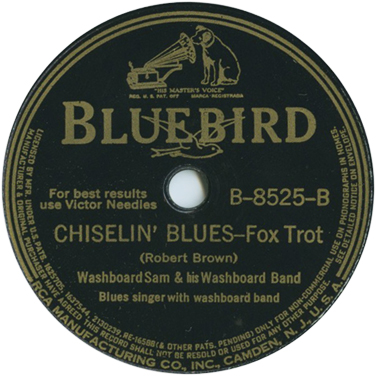
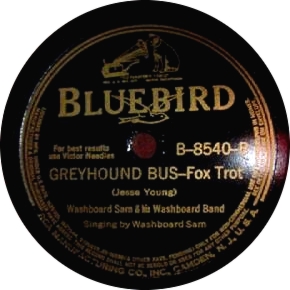
Washboard Sam (wbd, voc); Buster Bennett (as); Blind John Davis (p); Big Bill Broonzy (g); unidentified (broom and pail bass).
Chicago, August 5, 1940
| 049370 | I'm Going to St. Louis | Bluebird B8569, Montgomery Ward M8931, Blues Classics BC 10, Document DOCD 5175 | |
| 049371 | Greyhound Bus (Jesse Young) | Bluebird B8540-B, Montgomery Ward M8929, RST BD-2091, Document DOCD 5175 | |
| 049372 | Oh Joe (Joe McCoy) | Bluebird B8540-A, Montgomery Ward M8929, RBF RF-16, RST BD-2091, Document DOCD 5175 | |
| 049373 | Just Got to Hold You | Bluebird B8599-A, Montgomery Ward M8932, RST BD-2091, Document DOCD 5175 |
Our basic information derives from DGR and from the liners to Document DOCD 5175, Washboard Sam, Volume 5 (1940-1941). Bennett rates a "probable" in these sources; again, after one listen he can be safely upgraded.
Konrad Nowakowski alerted us to the composer credit on "Greyhound Bus." This belongs to one Jesse Young, an extremely obscure blues pianist whose entire known output consists of two unreleased sides for Session, done in Chicago in late 1943. However, Nowakowski confirms by ear that Blind John Davis was the pianist on the date.
The Bluebird and Montgomery Ward items were 78-rpm singles released at the time. The LP-era reissues are derived from Görgen Antonsson's Prewar blues & gospel on microgroove (http://sunsite.kth.se/feastlib/mrf/yinyue/pw/INTRO.HTM). RBF RF-16 was a various-artists LP from the 1960s; Blues Classics was a Washboard Sam LP from the 1960s; RST BD-2091 was a Washboard Sam LP issued in Austria in the 1980s. Two more cuts (049374 and 049375) were made at the end of the session without Bennett.
Buster Bennett was absent from the studios throughout 1941. Most likely he was not seeking studio work because he had begun leading his own combo. Starting in early July, Chicago Defender adverts indicate that Buster was ensconced at the Manchester Grill (473 East 31st Street). The Manchester Grill was the home of Valda Gray and his/her troupe of female impersonators. Valda Gray began in the early 1930s at the Cabin Inn, then moved to the Manchester. In mid-February 1942 his group of "ladies" would shift their operations to Joe's Deluxe Club, where they were in residence through much of the 1940s. While the ads did not always mention the female impersonator troupe, the write-ups did. On August 16, 1941, the Chicago Defender advertised Buster "Bennette" and his Band at the Manchester Grill. The ads throughout Buster's run continued to ornament his name in this fashion. A write-up from October 18, 1941, said that "The orchestra under the direction of Buster Bennette features Josephine Battle, female saxophonist that sends the jitterbugs with their moaning tunes." How long this two-horn lineup went on we do not now; we also don't know how Josephine would have fared on a chromosome test.

In any case, Buster was soon forced to disband after landing in the hospital with a serious respiratory illness. As soon as he got out, he joined Mike McKendrick's Swing Trio, which had been formed for the opening of the swanky new 411 Club, at 411 East 63rd Street. The guitarist/leader, Reuben "Big Mike" McKendrick, had previously played the banjo and guitar in Louis Armstrong's big band. (We had previously thought this engagement belonged to Gilbert "Little Mike" McKendrick, another veteran Chicago musician who played the same instruments and is probably most notorious for trading shots with Sidney Bechet on the street in Paris, back in December 1928. The Mikes are easy to mix up.) The pianist, Ralph Tervalon, had been on the scene since the mid-1930s. Meanwhile, to save lung power, Buster played string bass during this engagement. The engagement began October 11, 1941, and McKendrick's contract was accepted and filed by Local 208 on October 16, though we suspect Buster came on board a little later. The McKendrick trio was advertised in the Defender on December 27, 1941. The last Defender mention of McKendrick trio and the 411 Club was on January 31, 1942, but this was simply a function of the club no longer buying advertisements; the engagement ended on April 16. For the single recording session Buster picked up during this period, however, he was featured on alto sax.
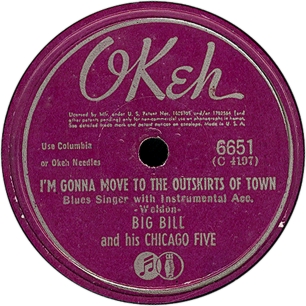
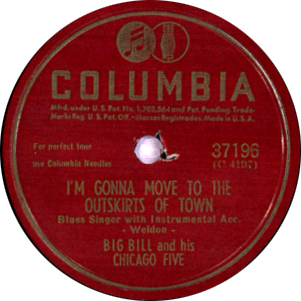
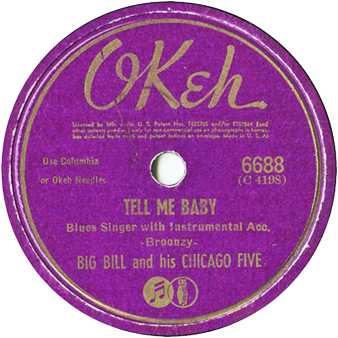
Big Bill [Broonzy] (g, voc); Ernest "Punch" Miller (tp); Buster Bennett (as); Memphis Slim [John L. Chatman] (p); Judge Riley (d).
Chicago, March 6, 1942
| C 4197-1 | I'm Gonna Move to the Outskirts of Town (Weldon) | OKeh 6651, Columbia 37196, "Columbia 30010," Biograph BLP C15, Document DOCD 5133 | |
| C 4198-1 | Tell Me Baby (Broonzy) | OKeh 6688, V-Disc 496, Columbia 37088, "Columbia 30007," Biograph BLP C15, Document DOCD 5133 | |
| C 4199-1 | Hard Hearted Woman (Broonzy) | OKeh 6651, Columbia 37196, "Columbia 30010," Biograph BLP C15, Document DOCD 5133 | |
| C 4200-1 | I'm Woke Up Now (Broonzy)^ | OKeh 6724, Columbia 37456, "Columbia 30023," Jazz Society [Fr] L-P 16, Biograph BLP C15, Document DOCD 5133 |
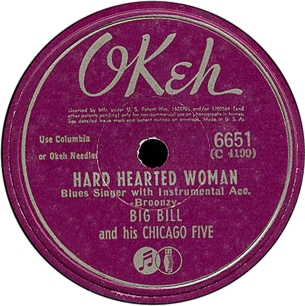
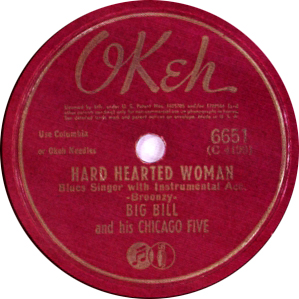
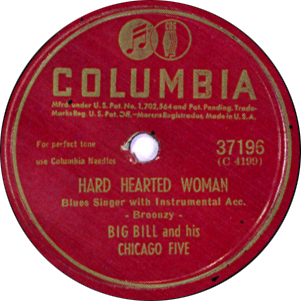
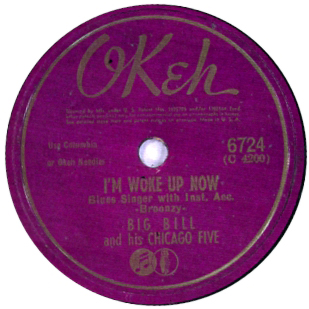
Our information comes from the liners to Document DOCD 5133, Big Bill Broonzy Volume 11 (1940-1942) which was released in 1993. OKeh 6651 was released in February 1944 (reviewed in Billboard on February 19, p. 44). OKeh 6688 was also released in 1944, but we have found no mention of it in the trade papers. OKeh 6724, listed as new release in Billboard on September 2, 1944 (p. 18), and reviwed on September 23 (p. 73), was attributed just to "Big Bill," likely because the other side was not from this session.
Columbia decided to discontinue OKeh around October 1945. Temporarily, it turned out; the subsidiary would get a last go-round in June 1951. All three of these Big Bill OKehs were deemed worthy of reissue, in Columbia's 35000 series: Columbia 37088 was reviewed in Billboard on October 12, 1946 (p. 31) and 37196 was first listed in Billboard on November 30, 1946 (p. 31). Columbia 37456 (we haven't found any mention of it in the trades) was most likely released in the spring of 1947. Our thanks to Howard Rye for filling in pre-compact disk era reissues. The Columbia 78s were also given numbers in the 30000 "race" series that the company adopted in October 1945, but to our knowledge 30007, 30010, and 30023 were never printed on labels or used in advertisements. V-Disc 496 is a 12-inch single made for the US armed forces during World War II. We learned more about LP-era reissues from Görgen Antonsson's Prewar blues & gospel on microgroove (http://sunsite.kth.se/feastlib/mrf/yinyue/pw/INTRO.HTM).
Apparently Buster was responsible for assembling the band that backed Big Bill on the March 6 session. We learn something of Buster's methods from the Local 208 Board meeting minutes for April 2, 1942, when Edward Sims (bandleader at Dave's Café and, soon, on off-nights at the new Rhumboogie Café) brought a complaint against him.
Edward Sims and "Buster" Bennett appeared before the Board as ordered. Sims stated that Bennett had engaged him to make a recording, but later called him two hours before the scheduled rehearsal and cancelled same, advising that the recording date would be postponed until the next week. Sims later learned that the recording was made the following day. Bennett agreed to pay Sims $10.00, which was agreeable. After three weeks, Bennett had not paid the money and became insulted when Sims called at his place of employment concerning the matter.
Bennett admitted that he had falsified when he informed Sims that the recording session had been postponed. He stated that Mr. Melrose had agreed to pay Sims the amount in question out of the next recording Bennett made. Under direct questioning, Bennett admitted that his recordings for Melrose were very uncertain. (p. 3)
They were plenty uncertain; a recording ban would hit at the end of July, shutting down the Melrose brothers' activities. The Melroses worked for Columbia and RCA Victor, which were the last to make a deal with Petrillo to resume recording, and Bennett was not to see the inside of a studio for nearly three years. The Board ordered Big Mike McKendrick to dock Bennett's pay for the next two weeks, to the tune of $28. Besides stiffing Sims, Buster had also borrowed $18.00 from the Local's Relief-Benefit Committee.
Buster's rehab assignment with the Big Mike McKendrick trio ended its six-month run, as we have mentioned on April 16, 1942 (McKendrick's new gig at the Whirl-a-way Cocktail Lounge was mentioned on Local 208's contract list for May 7). Unfortunately it would land him in serious trouble with the Musicians Union. On May 7, 1942, Buster and Ralph Tervalon were hauled in front of the Board on suspicion of working the gig for less than Union scale. Iley Kelly, the proprietor of the 411 club and one of Chicago's biggest policy wheel operators, had paid each of them just $30 a week, plus $1.50 for a noon hour session. After insisting to the Board that he was paid between $42 and $54 a week (depending on whether the trio also played lunch hours and the breakfast dance), Buster admitted that this wasn't the case:
When the audition was made, Mike McKendrick and Iley Kelly went off on the side and talked. He heard Kelly say, "damn that, will you work for my figure?" They started the engagement for $30.00 per week and received that amount until after they received the first notice. The trio then received $100 per week. During the time that they played the afternoon lunch hour, they received $1.50. They worked every night from 9 P.M. until 3:45 A.M. The boys paid one half the tax and the 411 club paid half. The highest price they ever received was $43.00 per week, and that was when they played the afternoon lunch hours and the Keno breakfast dance. (pp. 2-3)
On May 21, 1942, all three had to appear in front of the Local 208 Board, where they were charged with accepting a 6 day a week job for less than Union scale. McKendrick, who was supposed to be getting at least $35 plus $2 for each noontime session, had concealed the arrangement by faithfully paying "local tax" to the Union on an inflated weekly take. McKendrick pled financial hardship; Tervalon claimed he had been promised a raise (although Kelly never made good on the promise).
Bennett stated he had accepted the engagement under scale because he had just been released from the hospital and needed the work, as it afforded him the opportunity to play the bass violin instead of his saxophone, which would have been detrimental to his health. (p. 1)
McKendrick, Tervalon, and Bennett threw themselves on the mercy of the Board. They were socked with extremely heavy fines of $200 apiece ($75 due and payable by June 1; the rest held in abeyance if they stayed out of trouble with Local 208 for 6 months). Meanwhile Iley Kelly was hit with a default judgment of nearly $1300 (to cover the difference between what he actually paid the trio and Union scale), and put on the Union's Defaulters' List and the Unfair List.
Buster couldn't afford to pay the fine (plus the $28 that the Board had assessed him in April) and he ended up being "erased" for nonpayment. He went to work in the strip joints of Calumet City, which were outside of Local 208's territory.
On August 6
Erased member "Buster" Bennett appeared before the Board as ordered to explain why he had failed to pay his second quarter dues, reinstatement and other indebtedness to Local 208.
Bennett explained that he was working in Calumet City and had been advanced $30.00 with which to purchase a saxophone. He had to pay $5.00 per week on this amount to his employer. He promised to pay $12.00 Monday, August 10 and make payments every week thereafter on his Fine. (p. 2)
In search of further revenue, Buster announced that he was managing "Willette Williams, who chirps for patrons at the Rainbow Club in Calumet" (Al Monroe, "Swinging the News,"" Chicago Defender, August 8, 1942, p. 23). If anything further came of this business arrangement, we haven't seen it.
Later in the year Buster regrouped, paying off his debts to the Union, re-forming a band, and returning to the Manchester Grill; his contract (indefinite, for a 4-day week) was accepted and filed by Local 208 on November 19. From November 7 to December 12, 1942, the Defender ran Manchester Grill ads showing Buster Bennett and his Orchestra featuring W. Owens at the Piano. The blurbs for the club now described a revue format with dancers and singers, but no reference to female impersonators. An item in the Defender's "Cabaret" column for November 14, 1942 spells out the personnel (other than Buster) as Wendell Owens, piano, Chuck Barksdale, bass, and Kelly Funey, drums.
But around the middle of December Buster ran into a more serious spot of trouble. He was hospitalized again, for around 6 weeks, and was "erased" from Local 208's membership list once again, this time for nonpayment of dues. Wendell Owens had to take over as leader at the Manchester Grill (contract accepted and filed on January 7, 1943).
On February 4, 1943, Bennett pled with the Local 208 Board to restore his membership. We have reproduced the text in its entirety; there is nothing else to say.
James Joseph Bennett, an erased member of Local 208, appeared before the Board requesting reinstatement.
Bennett advised that he had been a patient at the Municipal Tuberculosis Sanitarium, and was still under treatment. He explained that he was told not to work, but he found this impossible, as he had to make a living. HE STATED THAT HE WAS WILLING TO SIGN A WAIVER FOR THE DEATH DONATION.
On motion, the Board ruled that James Joseph Bennett's request for reinstatement shall be granted, providing that he signed a waiver for the Death Donation.
This harsh policy was standard for musicians who suffered from TB and hadn't been declared cured by a physician.
Buster meant what he'd said; he went back to work as soon as he was reinstated. At the next Local 208 Board meeting, on February 18, 1943, his "indefinite" contract with the Vogue Tavern was accepted and filed. Buster next moved his trio from the Vogue to Millie's Lounge, where his 10-week contract was accepted and filed on May 6. However, he also put in some time at the Yes Yes Club, as we learn from the Board minutes of May 20, 1943; Bennett still owed $59 on his previous fines, which he would have to pay over the next 3 weeks "or stand erased from Local 208, and withdrawn from his engagement at the Yes Yes Club" (p. 1). The trio nonetheless worked at Millie's for most of the rest of the year. In June, Theresa Whitehead, "singsational vocalist and pianist" and bassist Walter Buchanan joined the group at Millie's (Al Monroe, "Swinging the News," Chicago Defender, June 19, 1943, p. 19). Bennett posted a second 10-week contract on November 18.
On January 20, 1944 the Board of Local 208 accepted and filed Buster Bennett's third contract with Millie's Cocktail Lounge; the contract ran for 8 weeks with options, but the options were not exercised. On March 3, 1944, the Buster Bennett Trio took over at Square's Steak House (the Defender item mentioned the previous engagement at "Miller's" Lounge.) A photo by Charles Stewart, now in the collection of Robert Pruter, shows Buster with Arrington Thornton (piano) and Duke Groner (bass); it was probably taken in early 1944 and ran with the ad on March 3, 1944. Buster shared the bill at Squares with Evanna Waterford Cotton (piano) and Charles "Crown Prince" Waterford, who was hyped as the "Bronze Sinatra."
Edward "Duke" Groner was born in Ardmore, Oklahoma on March 24, 1908. In the earlier part of his career he sang ballads in a high tenor voice and played a little piano. When he got married and settled in Chicago (probably in the summer of 1942) he was a veteran of the Nat Towles, Horace Henderson, and Jimmie Lunceford bands. He joined Towles in Dallas in 1935, remained with him during his years in Omaha (1936-1940), and was still with Towles in Fall 1940 when Horace Henderson raided nearly the entire personnel of the band and brought them to New York City. Although he was in the band when Henderson cut 4 celebrated tracks with the Towles personnel (October 23, 1940), Duke Groner did not sing on any of them. When Henderson ran out of bookings for the band (around December 1940) Groner remained in New York. He became a house singer at Minton's Playhouse in Harlem; the money wasn't too good but Thelonious Monk and Kenny Clarke were working there. He then replaced Jimmy Grissom as the ballad singer for the Jimmie Lunceford band for about 3 months in 1942. We first see him in Chicago in Al Monroe's Defender column on August 8, 1942 (p. 23): "Groner, the Horace Henderson vocalist, is one of the best in the game."
Groner started playing the bass so he would have another way to get work. At the beginning of 1944, he was ready to go public on the instrument. We know that he joined Local 208 on January 7, 1944; as a singer, he didn't have to. Initially, he may not have been terribly serious about the bass—is that why he posed at the piano in the Charles Stewart photo? (For an excellent biographical sketch of Duke Groner, see the profile by the late Charles Walton in his Bronzeville Conversations). Groner started his own piano trio in November 1944, when he had to replace Buster at the Cabin in the Sky (Buster was temporarily unable to play his saxophone, and had to take a gig playing piano at the Circle Inn). After two or three months of trio work at the Pershing Lounge, Groner seems to have resumed his association with Buster in 1945.
By 1946, though, he was committed to full-time work with his own ensemble. For instance, on June 6, 1946, Local 208 accepted and filed Groner's indefinite contract with the Argyle Show Lounge. In September, the trio was part of the new show at the Silver Frolics, which had just been remodeled (Chicago Sunday Tribune, September 29, 1946, part 6 p. 5). The first edition of the Groner trio included Ernest Ashby on guitar and Robert Montgomery (a frequent Buster sideman) on piano; a bit later Jimmy Bowman replaced Montgomery.
A still later edition of the trio, with Emmett Spicer (guitar) and Horace Palm (piano), recorded for J. Mayo Williams in 1947 and for Aristocrat in 1947 and 1948; Palm also contributed to the ballad singing. Duke Groner continued to lead trios for many years. In 1954-1955, he expanded to a quintet with Wallace Burton (ts); Turk Kincheloe (aka Kirk Stuart) (p); Hurley Ramey (eg); and Charles Walton (d). Later Porter Kilbert (as, ts) replaced Burton. In 1956, Groner's combo was featured for a time at Budland and Roberts Show Lounge. He recorded one session for Vee-Jay, which led to a single; we don't know which lineup he was using then, but judging from composer credits Turk Kincheloe was inolved and Ronald Wilson might have been there on tenor sax.
Duke Groner kept his quintet through 1960, and led a trio until 1973. Subsequently, he worked as a sideman, most often with traditional jazz bands. He was in Bill Reinhardt's last Dixieland band, which broke up in January 1977 when the leader retired; he continued in the band that Jim Beebe put together to replace Reinhardt's, recording with Beebe on two Delmark LPs made in 1978 and 1979. After leaving Beebe's band, Duke Groner continued to work frequently with drummer Barrett Deems. Duke Groner died in Chicago at the age of 84, on November 7, 1992.
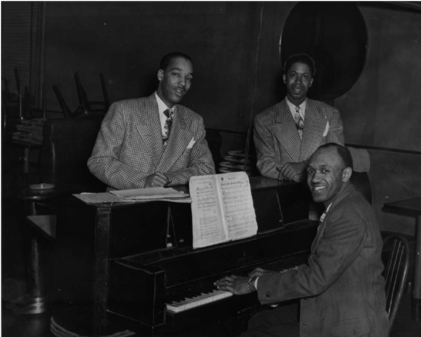
After a month or so at Square's, Buster and combo returned to Millie's; their four-week contract was accepted and filed by Local 208 on April 20, 1944; an 8-week extension posted on May 4. Buster Bennett was called in front of the Local 208 Board again on June 1, 1944 because he was delinquent to the tune of $21.44 in local tax. "Bennett explained that it was hard to collect the tax from the other two members of his trio, and that he took unnecessary remarks from them because musicians were hard to find who would stay on the job." He was also listed as being reinstated in the June 1944 issue of International Musician. Thanks to Howard Rye for this reference, which we think pertains to his being "erased" in December 1942; the listing when Buster joined the union remains to be located. On July 6, Buster posted a contract for 2 more weeks at Millie's. On July 20, a 4-week contract indicate that the band had moved to the Circle Inn (blues pianist and singer Byllye Williams took over at Millie's).

On September 30, the Defender announced that "Buster Bennett and his Trio which opens a long time engagement at the Cabin in the Sky 64th Street and Cottage Grove avenue, Sunday Oct, 1." (The contract was accepted and filed by Local 208 on September 21.) A photo of Bennett, Groner, and new pianist Wild Bill Davis accompanied this ad.

The Chicago Defender of October 28, 1944 ran a photo of Buster at the piano at the Circle Inn (a place later commemorated in one of his titles); the caption read "Buster Bennett, piano wizard" and averred that he had been "called back by popular demand." (Thanks to Howard Rye for catching this reference.) Buster had signed another contract for 16 weeks at the Cabin in the Sky, which was accepted and posted on October 19; however, on November 2, it was apparently superseded by Duke Groner's 12-week contract with the same establishment—Groner would continue at the club until January 14, 1945—and Buster's 4-week contract at the Circle Inn was accepted and filed at the same time. Buster was almost certainly compelled to feature the piano at this time for health reasons.
In any event he was able to return to the saxophone. In early January he worked two 3-day stretches at the Tradesmen's Club, then returned to his old haunts at Millie's for 4 weeks (both contracts accepted and filed on January 18, 1945). In February 1945 he landed his first recording session since the "recording ban" came down in 1942. Again Lester Melrose was involved, as he would be throughout Buster's career on record as a leader.

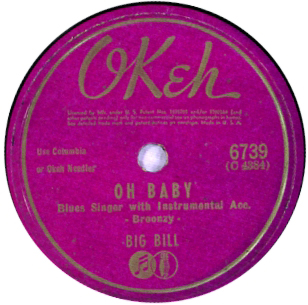
Big Bill Broonzy (voc, eg); Buster Bennett (as); Big Maceo (Merriweather) (p); Tyrell "T" Dixon (d).
Columbia Studios, Chicago, February 19, 1945
| C 4380-1 | Doing the Best I Can | Document BDCD 6047 | |
| C 4381-1 | Partnership Woman (Broonzy) | Columbia 30143, Swingtime [Fr] BT2001, Document BDCD 6047 | |
| C 4382 | Where the Blues Began | Document DOCD 5525 | |
| C 4383-1 | Humble Blues (Broonzy) | Columbia 36879, "Columbia 30002," Queen Disc [It] Q023, Document BDCD 6047 | |
| C 4384-1 | Oh Baby (Broonzy) | OKeh 6739, Columbia 37454, "Columbia 30021," Queen Disc [It] Q023, Document BDCD 6047 | |
| C 4385-1 | Cell No. 13 Blues (Broonzy) | Columbia 37164, Columbia 30009, Jazz Society [Fr] LP16, Swingtime [Fr] BT2001, Document BDCD 6047 | |
| C 4386 | Believe Me What I Say | unissued | |
| C 4387 | 1944 Blues | unissued |
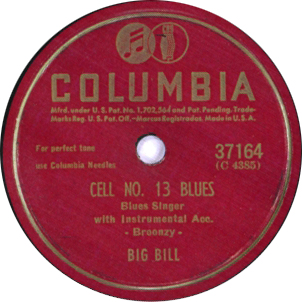
Our session information comes from Leadbitter and Slaven, Blues Records 1943-1966. LS do not provide take numbers, but these are included in the notes to Big Bill Broonzy Volume 12 (1945-1947), a 1995 release on Document BDCD 6047. "Where the Blues Began" finally appeared in 1995 on Document DOCD 5525, Too Late, Too Late: More Newly Discovered Titles and Alternate Takes, Volume 7 (1927-1995). The last two tracks from this session have never been issued.
Just four of the eight sides from this outing were released in the 1940s. OKeh 6739 was a 78-rpm single released in April 1945 (it appeared on the Billboard new release listings on April 28, pp. 25, 66). After OKeh was discontinued, and "race" releases moved to the Columbia 35000 series, Columbia 36879 hit the new release lists in Billboard on November 3, 1945 (p. 77). Columbia 37164 was listed in Billboard on November 9, 1946 (pp. 33, 102) and reviewed in Cash Box on December 2, 1946 (p. 12); Columbia 37454 was probably released in the spring of 1947, garnering no mentions in the trade papers. These three releases were also assigned numbers in the Columbia 30000 series for "race" records: 30002, 30009, and 30021. For two of these, we have no evidence that the 30000 series number was ever printed on labels or used in promotion. However, Columbia 30009, which may be a reissue of 37164 after May 1948, has shown up on ebay. "Partnership Woman" was nearly four years old when Columbia 30143 (a few months earlier, the company had started putting "race" series numbers on its releases) was reviewed in Billboard on December 4, 1948..
Thanks to Howard Rye for filling in the LP era reissues. Jazz Society LP16 was a French 10-inch LP from the 1950s; the Swingtime and Queen Disc LPs date from the 1970s.
The liners to the same Document CD incorrectly list Buster Bennett on the next Big Bill Broonzy session, which took place on February 24 (right after Buster's first session on his own) and consisted of matrix numbers C 4414 through C 4417. In fact, these were cut by Broonzy with Big Maceo and T Dixon only. Buster had his own recording contract now (it was duly recorded by the Board of the American Federation of Musicians on March 7, 1945; see the International Musician for August 1945, p. 19).
Discographers have carefully charted titles, matrix numbers, and releases of Bennett's sides as a leader, but the sum total of their personnels can be found in Bruyninckx, and subsequently in Lord: "Buster Bennett (as, voc) and others."
We have solved some of the problems now. We know from the late Otto Flückiger's capacious files the personnel of Bennett's combo in January 1948 (which we might expect to have something in common with the lineup he used on his last session at the end of December 1947). In January 1948, he was employing Robert Montgomery, piano; Israel Crosby, bass; Jimmy Crawford, drums; Fip Ricard, trumpet (for his last studio session, he had added an alto sax).
William Strethen "Wild Bill" Davis (born in Glasgow, Missouri, on November 24, 1918) came up playing guitar and piano in the Milt Larkin band, probably starting in 1939. He worked alongside Tom Archia in 1940-1941. He was around in February 1945, when Buster made his first session for Columbia, and Bennett used his tunes on other occasions. But Wild Bill was unavailable between July 1945 and October or November 1947; he was a regular member of Louis Jordan's Tympany Five during those days. Meanwhile, Arrington Thornton exited Buster's working group before Buster began recording. The pianist on the February 1946 and Charles Gray sessions is a blues and boogie musician, probably Andrew Jackson "Boogie Woogie" Allen; the pianist on the fifth Columbia session is Willie Jones (identifiable by ear); and the pianist on the sixth and last is Wild Bill Davis once again.
Israel Crosby's involvement on bass is clear on the last four Columbia sessions. The bass is not nearly so prominent on the first two sessions, and Duke Groner is the likely candidate for the second one. However, Duke Groner had taken over at the Cabin in the Sky in November 1944 when Buster ran into more health problems, and when that gig ended on January 14, 1945, he went to work with his trio at the Pershing Lounge (contract accepted and filed February 1; second contract posted March 15). What's more, Groner is not in the photo of the Bennett trio that appeared on February 3, 1945; Israel Crosby is. These activities do not preclude Groner's participation in Buster's second recording session; in fact, Groner's name disappears from the Local 208 contract lists after March 15, suggesting that he rejoined Buster's combo.
The drummer on the first three sessions has some karate-chop tendencies. Jimmy Crawford, who was reportedly working with Buster in January 1948, was in the military or working in New York City during the entire period of Buster's recording contract. And Buster didn't normally work with drummers in the clubs. This gives us little to work with as regards his studio drummers.
We have had mixed results identifying the saxophonists and trumpeters who appeared on some of his recording dates, but Buster did have a helpful habit of calling out the other horn soloists' names.
Before his first session as a leader, Buster adopted a tune called "Leap Frog" as his theme. He was still using it in 1950. The number is attributed to Bennett on his first release, but he didn't write it. "Leap Frog" was composed by Joe Garland. It was the opening theme for sets by the Les Brown big band, starting at some point during World War II (it is preserved on broadcasts from 1944). Les Brown did eventually record it in the studio, but his "official" version (also on Columbia, it turns out) was not cut till June 10, 1945—three and a half months after Buster's. No one at Columbia seems to have noticed the conflicting assertions of authorship!
To extenuate just a little, Buster does seem to have written a new bridge for the tune. He also restored a lot of the leap to the main strain, which Les Brown's band was prone to smooth out.

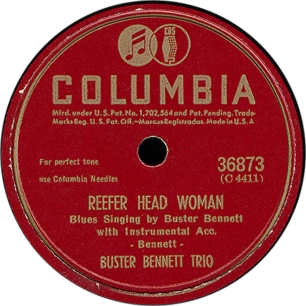
Buster Bennett (as, voc); "Wild Bill" Davis (p); Israel Crosby (b); unidentified (d).
Columbia Studios, Chicago, February 24, 1945
| CCO 4410 | Leap Frog Blues ("Bennett") | Columbia 36873, Columbia 30001, Classics 5037 [CD] | |
| CCO 4411 | Reefer Head Woman (Bennett) [BB voc] | Columbia 36873, Columbia 30001, Classics 5037 [CD] | |
| CCO 4412 | Don't Worry about a Thing (Bennett) [BB voc] | Columbia 37560, "Columbia 30052," Classics 5037 [CD] | |
| CCO 4413-1 | Broken Down Man (H. H. Melka) [BB voc] | Columbia 37560, "Columbia 30052," Classics 5037 [CD] |
The quirks of "Leap Frog Blues" (abrupt tempo shifts, unusual intervals for 1945) earned Buster the nickname "Leap Frog," which figured in advertisements for his combo thereafter. "Don't Worry about a Thing" is typical sardonicism, and "Broken Down Man" exhibits Buster's obsession with the extremes of down-and-outness.
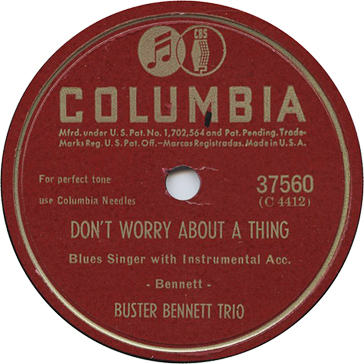
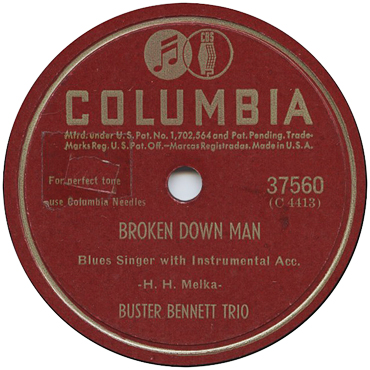
All but the last two of Buster's Columbia releases (all were 78 rpm singles, of course) were assigned a 35000 series numer and 30000 series number. The 30000 series, which officially with "Leap Frog Blues," was a "race" series; however, we have seen no evidence that such numbers as 30001 were actually put on labels (or mentioned in the trade magazines) until 1948. The 35000s were a general-circulation series that dated back to 1939 and included everything that Columbia was offering to white record buyers. Columbia 36873 appeared 7 months after the session; it was listed in the "Advance Record Releases" in Billboard on October 13, 1945 (pp. 31, 82). Columbia 30001 has shown up on ebay, but it may have been a reissue from 1948. The other two sides had to wait nearly two years: Columbia 37560 was released in July 1947 (Billboard, July 26, 1947, p. 120). We've put Columbia 30052 in quotes, because we've not seen a copy of it or heard of one.
Classics 5037, Buster Bennett 1945-1947, issued in June 2002, is the first comprehensive reissue of Buster Bennett's work as a leader. All 22 of the issued Buster Bennett and Charles Gray sides are included.
Apparently, "Leap Frog" had garnered enough jukebox play in its first month to six weeks that Metronome took notice—or maybe Columbia encouraged the magazine to. The December 1945 review section, handled by "The Two Deuces" (Barry Ulanov and Leonard Feather), gave the disk what were pretty much typical reviews in Metronome, B (good) for "Reefer Head Woman," and B- (fairly good) for "Leap Frog Blues." This was before grade inflation at the jazz magazines: Metronome gave very few As and very few Cs.
The review demonstrates how a mainstream jazz publication was inclined to treat blues records with a combination of condescension and respect. It also lets us know where Buster got "Leap Frog" from:
Typical race record, with Buster singing good blues and blowing some jumping alto on the first side, which is less lurid than its title, dealing not so much with marijuana as with marital infidelity. Leap Frog, as the title implies, is nothing but an adaptation of the Les Brown theme, which was written by Joe Garland, though Bennett gets the credit here; also the "blues singing" mentioned on the label is inaudible to us; it's strictly instrumental, alto and rhythm.
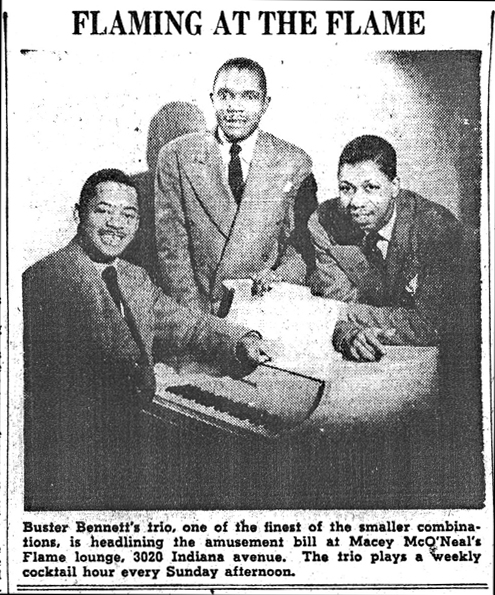
Shortly before the Big Bill session and his own first session for Columbia, Buster was said to be "Flaming at the Flame. The Defender of February 3, 1945, announced "Buster Bennett's trio (...) headlining the amusement bill at Macey McO'Neals Flame lounge. The trio plays a weekly cocktail hour every Sunday afternoon." The photo shows Wild Bill Davis and Israel Crosby alongside Buster. This engagement was for Sunday afternoons only; on April 5, Buster filed a contract with Local 208 for 8 weeks at the Flame that specified Sunday afternoons. (This Flame Lounge was not related to the bar of the same name that operated in the basement of the Morocco Hotel from 1952 through 1956.)
After the two sessions, Buster moved to the Tradesmen's Club in late February (his 4-week contract was accepted and filed by Local 208 on March 1; another one for 8 weeks followed on April 5). He was also continuing his Sunday afternoons at the Flame on April 7, when the Defender advertised "Tampa Red - Big Maco [sic] / Plus Buster Bennett and his famous Trio / Playing and Jiving at our regular Sunday Afternoon Cocktail hour." As of May 12, Buster was featured nightly at the Tradesmen's Exclusive Club, where the band was now billed as "Buster (Leapfrog) Bennett's Columbia Recording Trio." However, Buster's relationship with Ralph and Harold Lightfoot, who managed the club for their uncle Matt, would prove volatile. On July 5, 1945, Buster Bennett and Ralph and Harold Lightfoot appeared before the Local 208 "to clarify certain conditions on the job."<.p>
Harold Lightfoot stated that he told Bennett to turn on the vendor [i.e., the jukebox] when he finished the set (June 29, 1945) and that Bennett got himself into a heated argument with him, saying that he was an artist and not a flunky. One word lead [sic] to another and he told Bennett that if he could not do as he was told he could leave the engagement. Bennett and his trio left Trademen's [sic] and reported the matter immediately at President Gray's home.
Although the Union was willing to let Buster leave right away, he worked most of the following two nights because he had been asking for advances on his salary and still owed Ralph Lightfoot $25.00. On July 2, Buster arrived at the Tradesmen's Lounge only to take his trio over to the Circle Inn, which was next door.
Member Bennett was severely reprimanded for his conduct on the engagement and his method of drawing his salary always a week or more in advance. He was warned that unless he could prove himself a better contractor that this right would be denied him.
Buster was ordered to pay Ralph Lightfoot back, fined, and also met with a demand to pay $50 in delinquent local tax.
Buster's move to the Circle Inn seems to have been a momentary expedient. On June 5, he filed a contract at the Hurricane Show Lounge, for 4 weeks with options. Per a Defender ad, he was still there on September 1, when the "Harlem on Parade" revue at the Hurricane included Buster "Leap Frog" Bennett and his Band.
On October 6, a small article headlined "Trio Returns to Circle Inn" declared that the Buster Bennett Trio would open there on October 15 (contract for 4 weeks with options accepted and filed on November 1). The event was duly commemorated at Buster's next session.

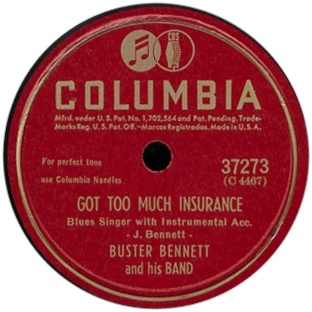
Buster Bennett (ss, voc); Jim ... (ts); poss. James Kincaid (p); Duke Groner (b); unidentified (d).
Columbia Studios, Chicago, October 24, 1945
| CCO 4465 | Circle Inn Stomp | unissued | |
| CCO 4466 | Let Me Love You, Baby (J. Bennett) [BB voc] | Columbia 30148, Classics 5037 [CD] | |
| CCO 4467-1 | Got Too Much Insurance (J. Bennett) [BB voc] | Columbia 37273, "Columbia 30013," Classics 5037 [CD] | |
| CCO 4468-1 | Mellow Pot Blues (J. Bennett) [BB voc] | Columbia 37346, "Columbia 30018," Classics 5037 [CD] |
Buster plays soprano sax on the three tracks that have been issued. He shouts "Blow it, Jim, blow it!" during the tenor sax solo on "Mellow Pot." We used to think this was Jimmy Coe, but Dan Kochakian's interview with Coe rules this out (in 1945, Coe spent two weeks in New York after mustering out of the Army, then returned directly to Indianapolis). So we still need to identify the tenor player. One James Kincaid worked with Buster during this period, but Kincaid appears to have been a pianist, not a saxophonist (see below).
Blues researcher Michel Chaigne (email communication, February 20, 2006) pointed out that the immediately preceeding session for Columbia (matrix numbers CCO 4461 through 4464) featured James "Beale Street" Clark (vocal), J. T. Brown (clarinet), Roosevelt Sykes (piano), and an unidentified bassist. But "Jim" on this date does not sound like J. T. Brown, who always had that "nanny goat vibrato."

Columbia 37273 was listed in Billboard among the new releases for February 22, 1947 (p. 29) and reviewed on April 12, 1947 (p. 29). Columbia 37346 was listed on May 10, 1947 (p. 122) and reviewed in Billboard on June 7, 1947 (p. 31). The "race" series numbers, 30013 and 30018, appear to have been for bookkeeping only; anyone who has actually seen a 78 with either of these numbers on it should let us know. By contrast, Columbia 30148 was the company's last Buster Bennett issue. Having made the changeover to 30000-series numbers in May 1948, with 30120 by Memphis Minnie, the company had already put out 30132 on Bennett. Columbia 30148 was released in December 1948 (listed in Billboard, December 18, 1948, p. 34). It was reviewed quite negatively on January 1, 1949, p. 89, though the anonymous critic liked "Let Me Love You" a lot better than its flip.
Classics 5037, Buster Bennett 1945-1947, issued in June 2002, is the first comprehensive reissue of Buster Bennett's work as a leader. All 22 of his issued sides are included.
The matrix numbers carry no suffixes on the original issues; take numbers appear in the company files only.
Duke Groner seems to have left Buster's combo for good at the end of 1945. On December 20, 1945, he posted a contract for 2 weeks with options at Mickey's Lounge, followed by an indefinite contract with The Tailspin (January 3, 1946). After that Groner's name shows up regularly on the Local 208 contract lists. By the fall of 1946 Groner had steady work with his trio; in 1947 the trio would record for J. Mayo Williams and in 1947 and 1948 it would get two sesssions on
Aristocrat.
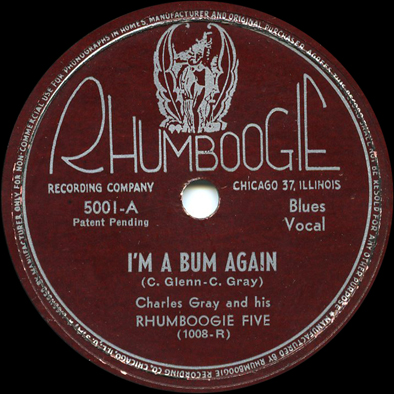
Charles Gray (tp); Buster Bennett (voc, ts); Andrew Jackson "Boogie Woogie" Allen (p); Israel Crosby (b); unidentified (d).
Chicago, prob. January or February 1946
| 3315-2 (1008-R) | I'm a Bum Again (Glenn-Gray) | Rhumboogie 5001-A, RST 91577 [CD], Classics 5037 [CD] | |
| 3316-2 (1009-R) | Crazy Woman Blues (Glenn-Gray) | Rhumboogie 5001-B, RST 91577 [CD], Classics 5037 [CD] |
Rhumboogie 5001 was a 78-rpm single released in 1946. Both sides were reissued in 1994 on RST 91577, an Austrian CD collection titled Chicago Jump Bands: Early R&B Vol. 1, 1945-1953. In the liner notes to the RST, Frank Saturn opines that Charles Gray was in fact Buster Bennett, disguising his identity while under contract to Columbia. Buster's singing is instantly recognizable, and anyone can see why he wasn't being advertised as the leader.

Classics 5037, Buster Bennett 1945-1947, issued in June 2002, is the first comprehensive reissue of Buster Bennett's work as a leader. All 22 of his issued sides from Columbia and Rhumboogie were included.
Contrary to Saturn's surmise, Charles Gray was a real person. Born in Wisconsin on September 7, 1918 (the membership files at the Chicago Federation of Musicians and Social Security records agree on the date), Charles was the son of bassist Harry W. Gray, who joined the segregated Union local in 1928 and had been its president since 1937. Walter Allen, who interviewed Gray for his book Hendersonia, commented that Gray "claims to be from Chicago but sounds Southern in speech" (p. 562). (Harry Gray was originally from Tennessee, Charles' mother Lina was from Wisconsin, and the family did not arrive in Chicago until Charles was 10.) Charles Gray, a good Swing trumpeter, had played in a very early Nat Cole band (1934, according to Allen), with Eddie Cole and Carroll Dickerson in 1935, and with Stuff Smith and John Kirby at unspecified dates. And hiring Harry Gray's son for recording dates certainly wouldn't have hurt Buster's often strained relationship with Local 208!
There is no mystery as to Gray's absence from the Buster Bennett band after this session: he took over the first trumpet chair in the Fletcher Henderson band at the Club DeLisa in August or September of 1946, after Elisha Hanna quit. When Fletcher departed the DeLisa on May 18, 1947, leaving most of his musicians high and dry, Gray was promptly recruited to play lead trumpet for the bulked-up Red Saunders band. He left Saunders in 1948 and we have not positively identified him as being on any Red Saunders recordings. Gray did play trumpet on two Chicago sessions behind Big Joe Turner (for National, on November 29 and December 9, 1947). What we can hear of Charles Gray on those sessions is consistent with the sound of the trumpet on these Rhumboogie items—as well as on Buster's previous session for Columbia. Besides, on "I'm a Bum Again" Buster sings, "And my friends like Charlie, they just laugh in my face."
We don't know much about Charles Gray's activities in succeeding years, though he remained on the scene and was voted a lifetime membership in the Chicago Federation of Musicians on June 6, 1979 (Charles was not prominent locally, so this was obviously done on account of his father's holding a leadership role for so many years). Charles Gray got behind on his dues and was stricken from the membership rolls in 1987; he died in Las Vegas, Nevada, on March 6, 1995. (Our thanks to the late Eric Leblanc for research on Charles Gray.)
Buster may have intended this session as a trial balloon; he had not played tenor on any previous recording. Except for a brief intro to each side, Boogie Woogie Allen sticks to Boogie 101 comping patterns at nearly the same tempo on both sides. LS and other sources do not identify the bass player and drummer, but they appear to be Buster's regulars from this period. (When Charles Gray recorded behind Joe Turner, the rest of the band consisted of Riley Hampton on alto sax, Otis Finch on tenor sax, Robert Moore on piano, Ike Perkins on electric guitar, Ellsworth [E. L.] Liggett on bass, and James Adams on drums. Except for Moore and Perkins, all of these musicians had been in the Fletcher Henderson band at the Club DeLisa, which ended its residency on May 18, 1947. Judging from the November 29, 1947 sides, Moore is definitely not the pianist on this date. Whether Adams could have recorded with Buster Bennett calls for more research.)
While the RST set gives 3315 and 3316 as the matrix numbers (these appear in the trailoff shellac), the label of "I'm a Bum Again" shows 1008-R and the label of "Crazy Woman" shows 1009-R. 3315 and 3316 belonged to a QB 3300 matrix series allocated to Rhumboogie by RCA Victor (actually in 1945, when the first T-Bone Walker session for Rhumboogie was mastered and pressed—but the D5 prefix that would mark the year was left off).
The most embarrassing incident that we know of in Buster's career blew up on February 21, 1946. Buster made the mistake of picking a fight with another musician who was also on the Board of Local 208. Preston Jackson (1902 - 1983), a jazz trombonist from New Orleans who had been on the Chicago scene since 1917, had loaned Bennett $2 several months before, and decided to collect one night at the Circle Inn:
Jackson explained to the Board... that he happened to be out on 63rd Street and stopped in the Circle Inn. Approaching Bennett he complimented him upon his appearance and casually mentioned the fact that he would like to collect his $2.00, saying, "you can mash those two bucks on me, I could use them now." Jackson continued why [sic] stating that Bennett virtually turned to a cage of apes, and proceeded to use profane language as well as threatening remarks. Jackson stated that he finally said "if you don't pay me I will take the matter to the local". This only incensed Bennett more, and it was at this point that he replied, "Yes - and if you do that I will cut your M——-F—-ing throat.["] When the bartender and other bystanders came up and asked Buster what the trouble was all about, Bennett told them "This hungry S of a B wants me to give him $2.00", and proceeded to tell a disinterested crowd of people about his making it possible for him to make some recordings and giving him the leader's fee.
Harry Gray had to call for order and send Bennett and Jackson out of the room while the Board was deliberating. They promptly started a fist fight, which another member of the Union broke up. The Board ruled that Buster had to pay Preston Jackson his $2.00 on the spot, then fined both of them $25 for "conduct unbecoming a member of Local 208."
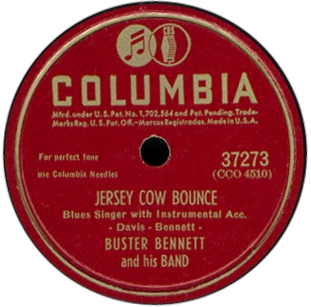

Buster Bennett (ss, voc); Charles Gray (tp); Andrew Jackson "Boogie Woogie" Allen (p); Israel Crosby (b); unidentifed (d).
Columbia Studios, Chicago, February 27, 1946
| CCO 4510-1 | Jersey Cow Bounce (Davis-Bennett) [BB voc] | Columbia 37273, "Columbia 30013," Oldie Blues [Nl] OL 8014, Indigo IGOCD 2093 [CD], Classics 5037 [CD] | |
| CCO 4511 | I Want to Woogie Woogie* (Bennett) [BB voc] | Columbia 37071, "Columbia 30006,: Oldie Blues [Nl] OL 8014, Hoy Hoy 40-S-01 [CD], Stash STB-2516/7 [CD], Classics 5037 [CD] | |
| CCO 4512 | Don't Jive Me Baby* (Bennett) [BB voc] | Columbia 37071, "Columbia 30006," Classics 5037 [CD] | |
| CCO 4513-1 | Signifying Woman (Allen) [BB voc] | Columbia 37346, "Columbia 30018," Classics 5037 [CD] |
Lord titles CCO 4511 "I Want to Boogie Woogie." The label on Columbia 37071 gives the title as "I Want to Woogie Woogie." Buster sings "He wants to boogie, he wants to boogie, he wants to boogie woogie woogie woogie woogie." Oh well...
Oldie Blues OL 8014, Screaming Boogie: Hot Screamin' Saxes from Chicago 1947-1951, was an LP released in the Netherlands in 1986.
The CD reissue on Hoy Hoy 40-S-01, a collection released in 1992, gives the title as "I Want to Boogie Woogie." As does The Hoy Hoy Collection: Rock Before Elvis! on Stash STB-2516/7, a various-artists 2-CD set from 1995. Indigo IGOCD 2093, Rhythm & Blues All Stars Volume 1: Jump with a Shuffle, is a various-artists CD released in Britain 1999; thanks to Joseph Nathan Scott for alerting us to this one. The other tracks are by Dinah Washington, Gatemouth Moore, Joe Liggins, Amos Milburn, Louis Jordan, et al.
Columbia's "race series" numbers 30006, 30013, and 30018 appear to have been purely notional, but we will be happy to stand corrected if anyone has seen 78s with these numbers on them. The first two sides selected for release appeared on Columbia 37071 (listed in Billboard on August 31, 1946, p. 30; reviewed on September 7, p. 33). "Jersey Cow Bounce" was used for Columbia 37273, reviewed in Billboard on April 12, 1947 (p. 124) after being listed on February 22 (p. 29). "Signifying Woman" was on the next single, Columbia 37346, listed on May 10, 1947 (p. 122) and reviewed in Billboard on June 7, 1947 (p. 31).
Classics 5037, Buster Bennett 1945-1947, issued in June 2002, is the first comprehensive reissue of Buster Bennett's work as a leader. 22 sides are included: 20 under Buster's leadership and 2 under Charles Gray's.

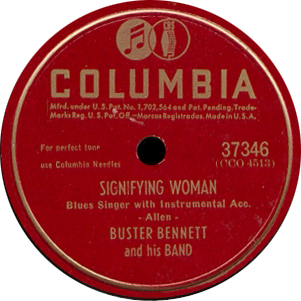
Again, take suffixes are from the company files; they were not included in the matrix numbers on the original issues.
The band is larger than the "Buster Bennett Trio" mentioned on the label of Columbia 37071. The pianist is a blues man; in fact this session (and the Rhumboogie session, probably done shortly before it) are the most boogie-oriented of any under Buster's leadership. Boogie Woogie Allen (see below) is the obvious suspect. The trumpet player is a Swing musician, who mostly plays muted. On "He Wants," Bennett says as he moves off mike, "Boogie, Charles, boogie." For a positive sign of Israel Crosby, check out the last note of "Don't Jive Me."
"Jersey Cow Bounce" is co-credited to one "Davis." The sound of the piece makes it clear that this was "Wild" Bill Davis. From summer 1945 to the fall of 1947, Davis was touring with Louis Jordan's band, but he would be back in Chicago in time to participate in Bennett's last session, on December 30, 1947.
The "Allen" who is credited as the composer of "Signifying Woman" appears to be Andrew Jackson "Boogie Woogie" Allen, who in November 1945 had reportedly been signed to the Rhumboogie label. Boogie Woogie Allen worked regularly in the Chicago clubs from 1946 through 1949, most often as a solo pianist. In fact, during February 1946 Allen did not apparently have a solo gig anywhere in Local 208's territory. If Allen did in fact record solo or as a leader for Rhumboogie, the sides were never released; we believe he did appear on Buster's clandestine session for that label.
Although it's been helpful to us as researchers to see Allen credited for "Signifying Woman," there's a good chance he didn't write it. Big Joe Louis points out that "Signifying Woman," with all four of the same verses that we hear on Buster's recording, was cut a year and a half later for RCA Victor, by Jazz Gillum (accompanied by Bob Call, Willie Lacey, Ransom Knowling, and Judge Riley, November 10, 1947; released on 78 as RCA Victor 20-3250 and on 45 as RCA Victor 50-0004). The label to Victor 50-0004 credits Robert Brown (Washboard Sam) as the composer, and in Gillum's rendition it does sound like a Washboard Sam number.
The Defenders for April 13 and 20, 1946, have Buster Bennett's Band still at the Circle Inn. Thereafter Buster moved back next door to the Tradesmen's Show Lounge, 6420 Cottage Grove; an indefinite contract for Joseph "Buster" Bennett and the "Trademen's Club" was accepted and filed by the Local 208 Board on April 18. Sure enough, a Defenderad from April 27 for "Buster 'Leap Frog' Bennett and His Combo" announced his return to the Tradesmen's.
Matt Lightfoot (the proprietor of a moving company who also owned the club) had been trying to get Buster back into his establishment for some time, repeatedly approaching him while he was working the Circle Inn, and this led to bad blood with Sam Henderson, whose combo would be displaced from the Tradesmen's when Buster returned. After being given four weeks' notice that his engagement would be terminated, Henderson brought a complaint against Bennett for "maliciously and willfully undermining him for his current engagement before the proper notice of termination was given him." In front of the Union Board on April 4, 1946
Mr. Matt Lightfoot, arguing in Bennett's defense, denied Henderson's charges. He denied that Buster Bennett had approached him at any time during the engagement of Henderson for the job, and made it clear that he had contacted Bennett a dozen or more times, and had gone to his hotel, in an effort to get him back in Trademen's [sic] Club. He told the Board that he had no ill feeling against Henderson, but that he was not satisfied with the business at the club, as any orchestra could play to a full house on week ends, while Bennett was the only one that could make the club do business every night.
Ralph Lightfoot corroborated his uncle's statement that "he had always liked Buster because he brought business to the club while playing there." Interestingly, the testimony also revealed that Buster had held a rehearsal for a recording session at the Tradesmen's (for either the Rhumboogie session, or the February 27 session for Columbia) and that "drums were not used." So Buster was still not carrying a drummer in his working band. On this occasion, the Union Board ruled in Buster's favor, authorizing him to begin his stand at the Tradesmen's on April 29. Buster was there a little over a month.
Buster would soon make a second clandestine appearance on record. His presence on bandleader Red Saunders' session for Sultan eluded discographers for more than half a century—we are indebted to the keen ears of Armin Büttner.
How Buster ended up on a Red Saunders record we don't quite know—as both were highly active in the Chicago clubs at the time, they would have known each other, but Buster was never on stage at the Club DeLisa, and he wouldn't work a Loop club till after this session. Perhaps label owner Morton Sultan, who had studied piano in Chicago and knew the local scene pretty well, figured that he could boost the appeal of his Red Saunders sides by adding a blues singer who was packing them into local clubs.

Red Saunders (d, voc, ldr); George "Sonny" Cohn (tp); Joseph "Buster" Bennett (voc, as -1); Nat Jones (as); Leon Washington (ts); Porter Derrico (p); Mickey Sims (b).
Chicago, May 1946
| S-109-1 | Red, the Be Bop Guy ("Saunders") -1 | Sultan 2501B | |
| S-111-1-1 or S 111-1-2 | Vi, Tell Me Why (Dean-Saunders) | Sultan 2503A |
Leadbitter, Fancourt, and Pelletier (1994) list this session. Years earlier, Jepsen was more accurate with the titles, mentioning "Red, the Be-bop Guy," instead of "The Be-bop Guy." Both sources wrongly claim that the session was cut in Detroit. True, Sultan Records was run out of Detroit, but all of the company's artists were performing in clubs on Randolph Street in Chicago's Loop, and the company's recording sessions, which are all in the same matrix series, took place in Chicago.
An advert for the Sultan label in the June 8, 1946 issue of Billboardclears up some details. The Sultan gimmick was "double-header hits," which meant sides by two different bands. "Red, the Be Bop Guy" was the B-side of Sultan 2501 (not 2502 as listed in previous discographies); the A-side was "Orientale" by the Eddie Wiggins Sextette. "Vi, Tell Me Why" shared its "double-header" disc with "Sonny's Boogie" by Sonny Thompson, who was billed for the occasion as "Prince of the Ivories."
Sultan 2501 and 2503 were 78-rpm singles, released in June 1946. There wasn't much more to the Sultan label than this debut release of 3 singles. A fourth jazz single, by the Chet Roble Trio, was mentioned in Billboard but we have no confirmation that it was released. There could even have been one more Sultan session with jazz content, surviving on account of being sold to another label (see below). Probably in 1947, Sultan recorded Jewish religious music and some Yiddish songs by Cantor Hyman Adler in Detroit, with some of the sides being released before Morton Sultan sold the masters. Sultan also put out two Country singles, more 1947 recordings from Detroit. Although Morton Sultan was still listing his label in the trade papers' directories as late as 1952, he was primarily involved in several other businesses, such as a record distributor, an appliance store, and a radio and TV store, all of which had failed by then. Morton Sultan eventually moved to Southern California, where he enjoyed some degree of success selling real estate.
If the Saunders band recorded more items for Sultan (matrix S-110 or S-112?), these appear to be lost. A copy of Sultan 2501 in Tom Kelly's collection supplies the label copy and the matrix number. "Vi, Tell Me Why" appears on one side of Sultan 2503 (a copy in George Paulus' collection has the -1 suffix after the matrix number; Dani Gugolz' copy has the -2; these may simply be different stampers.)
"Red, the Be Bop Guy" features an unadvertised guest. Sultan was indulging in false advertising when it attributed the vocal to Red. The vocalist is none other than Buster Bennett and the tune is a fairly fast blues of the "celebrity roast" variety.
He's hip and he's handsome, he's mellow and fly
Yes, he's hip and handsome, he's mellow and fly
The gals all call him Red the bebop guy
He has so much trouble to keep the chicks from his flat
Yes, so much trouble to keep the chicks from his flat
He has to beat 'em off with a baseball bat...
You may think he's boasting, he's just a big sack of wind
Yes, he's boasting, he's a big sack of wind.
Then he's the biggest sack since time began.
The words are obviously Buster's, and could well have been improvised at the session—but Red snagged the composer credit. Some of the riffing in between Buster's vocal lines would reappear when Red's combo backed Big Joe Turner for National in October.
Sonny Cohn gets a prominent trumpet lead in the introduction and the tag. In the middle of the piece, there are two 12-bar solos on the alto saxophone. The first solo, stuffed with 8th and 16th notes in the mid-1940s Tab Smith manner, is obviously the work of Nat Jones. The second 12 bars are strictly gutbucket and enunciated with a rasp—Buster's doing. And the second solo ends with a rest (to give Buster time to take the sax out of his mouth and resume singing). Buster also briefly joins the closing ensemble.
Nary a trace of bebop can be found on "Red, the Be Bop Guy," but the Saunders band eventually mastered the style, as can discerned from their rendition of "Synthesis" and another instrumental of uncertain title for the Supreme label.
The Billboard ad for "Vi, Tell Me Why" mentions "Nat Jones on the sax," rendered on the label as "Nat Jones on Sax." Vi Kemp, a contortionist and singer, was Red Saunders' wife. She is mentioned in many subsequent Chicago Defender advertisements for the Club DeLisa (May 17, 1947, December 18, 1948, and December 31, 1949, among others). "Vi, Tell Me Why" was a rather sappy ballad dedicated to Vi, but not featuring her. As promised, Nat Jones has the schmaltzy alto sax lead and the frilly conclusion; there is also a brief trumpet lead from Sonny Cohn.
In June, Buster got his first opportunity to work in the Loop, for a primarily White audience. (One wonders whether it was Saunders—who had been working Loop clubs for nearly a year—or Morton Sultan who put in a word for him.) On June 6, 1946, the Local 208 Board accepted and filed his contract with Lipps' Lower Level, for 4 weeks with options. Buster was playing alternating sets with a combo led by tenor player Robert "Little Sax" Crowder, whose contract was accepted and filed on the same occasion.
We note that a Defender ad from September 28 and October 10, 1946, mentions four musicians who were appearing at the Zanzibar as the Four All-Stars: James Kincaid (formerly with Buster Bennett), Eugene Wright (formerly with the Dukes of Swing), Chuck William [sic] (formerly with Lester Young), and Thomas Crump (formerly with Billy Eckstine.) "Chuck William" was presumably Charles Williams, the drummer. Eugene Wright played bass; he would re-form the Dukes of Swing in 1947 (see the Dozier Boys discography for his first recording session as a bandleader). Thomas Crump was a tenor saxophonist. By process of elimination, we may fairly conclude that Kincaid (who filed the contracts with the Union as the leader) played piano. Whether he had just left Buster's band, or been in it at some point during the preceding two years, we don't know for sure.
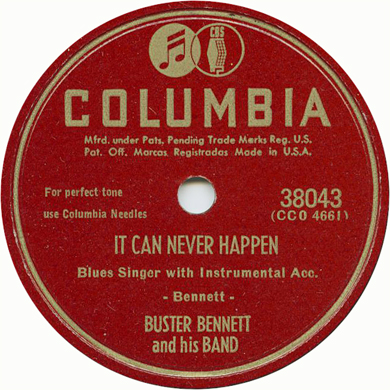
Buster Bennett (ts, voc); Harry "Pee Wee" Jackson (tp); Andrew "Goon" Gardner (as); unidentified (p); Israel Crosby (b); unidentified (d); Paul King (arr).
Columbia Studios, Chicago, September 30, 1946
| CCO 4661 | It Can Never Happen (Bennett) [BB, ens voc] | Columbia 38043, "Columbia 30106," Classics 5037 [CD] | |
| CCO 4662 | Dive to the Bottom Blues | unissued | |
| CCO 4663 | Dog House Blues | unissued | |
| CCO 4664 | Let's Go Fishin' | unissued |
There is less to go on here than we would like, as three tracks have never been released. Either Buster or his recording director seems to have decided that it was time to move beyond the rather rough-hewn blues that came out of the first three Columbia sessions (plus the Rhumboogie). "It Can Never Happen" is a riff-based Swing number with a group refrain—pretty suave stuff for Buster. (It sounds like a Wild Bill Davis composition, but Bennett got sole composer credit on the label.) Columbia 38043 was released in December 1947 (see the Billboard listing for December 27, p. 31). We've seen no evidence of an actual record with Columbia 30106, but anyone who has encountered one, please let us know.
Judging from their titles, the other pieces may have been held back because of their resemblance to Buster's earlier sides (or because he had made an unauthorized appearance on Aristocrat singing "Let's Go Fishin'" before the Columbia executives got around to putting anything out from this session—see below).
Classics 5037, Buster Bennett 1945-1947, issued in June 2002, is the first comprehensive reissue of Buster Bennett's work as a leader. All 22 issued sides from the Buster Bennett and Charles Gray sessions are included.
Buster has completed his move to tenor now; his rhythm is less incisive on the instrument, but his manner is unusual, as always—like a gutbucket clarinet conception transferred to the tenor sax. Buster helpfully shouts "Blow it, Pee Wee, blow it," and Pee Wee Jackson's familiar rasp is in evidence. The alto sax sounds like Pee Wee's partner in the 1947 Dave Young Orchestra, Goon Gardner. Gardner represents the front edge of a bebop incursion into Buster's music.
No title is given for CCO 4662 in Lord, but according to Howard Rye, who has inspected the Columbia Artist Index Card for this session, the title was "Dive to the Bottom Blues." "Let's Go Fishin' " is presumably the same number as the Bennett-composed "Fishin' Pole" that he sang with Tom Archia and his All Stars in July 1947 (see the Archia discography and Ben25 below).
From the Local 208 Board minutes for January 2, 1947, we learn that trumpeter Paul King had been promised S40.00 for writing arrangements for this session, which was supervised by Lester Melrose. When King pressed his claim, Bennett "stated that King did not make arrangements, only introductions and riffs. He stated that King was to have made the session with him but went to New Orleans for four weeks instead." However, Buster had obtained the $40 from Melrose which supposedly was going to go to King. The Board ordered him to pay Paul King over the next month.
In December 1946, Buster Bennett went into the Brass Rail (his indefinite contract with the Loop establishment was accepted and filed by Local 208 on December 19). On February 8, 1947, the Defender ran an ad for "Buster Bennett and His Famous Trio" at the Celebrity Club. An accompanying news item stated that "Buster Bennett, currently featured at the Brass Rail, downtown nightery, and who played the Cocktail Party at the Celebrity Club in Macey McOneal's Hotel Pine, 4015 Lake Park Ave., last Sunday is being brought back this Sunday by popular demand. The announcement was made by Macey McOneal, owner of the hot spot. Buster who is in the loop with [violinist] Eddie South, will perform at the Celebrity Club in the afternoon before his nightly appearance at the loop cafe."
On April 5, 1947, the Defenderran a picture of Buster's trio (actually a slightly cropped version of the same photo that had run in connection with his Flame Lounge gig on February 3, 1945). The caption read, "Moves To Tradesmen's Club. Buster Bennett and his trio, shown above, move into the Tradesmen's Club, 6240 Cottage Grove, this week after several months at the Brass Rail, Loop nightery. Buster heads an entertainment bill that rates the Tradesmen's Club with any cafe in Chicago." In fact, Buster's contract for 4 months at the club was accepted and filed by Local 208 on April 3. (We know from Bennett's April 1946 dispute with Sam Henderson—see above—that the Tradesmen's was an ambitious nightery that maintained a floor show.) Another ad for Buster at the Tradesmen's ran on May 31.
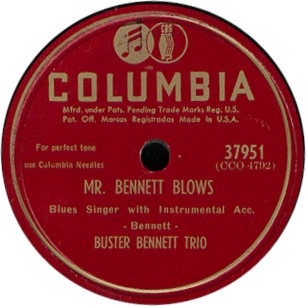
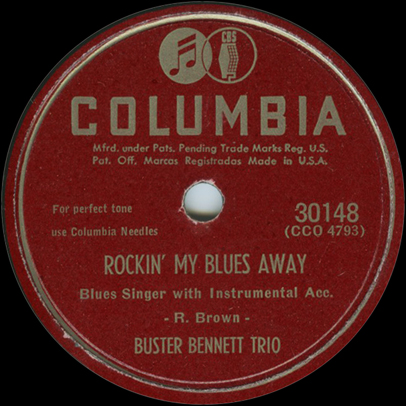
Buster Bennett (ts -1, as -2, voc); Willie Jones (p); Israel Crosby (b); unidentified (d).
Columbia Studios, Chicago, June 11, 1947
| CCO 4792 | Mr. Bennett Blows (Bennett) -1 | Columbia 37951, "Columbia 30100," Classics 5037 [CD] | |
| CCO 4793 | Rockin' My Blues Away (R. Brown) [BB voc] -1 | Columbia 30148, Classics 5037 [CD] | |
| CCO 4794 | Buster Bennett Medley: You Are Too Beautiful - Weary River [BB voc] -2 | Columbia 38043, "Columbia 30106," Classics 5037 [CD] | |
| CCO 4795 | Hard Luck Blues (Bennett) [BB voc] -1 | Columbia 37951, "Columbia 30100," Classics 5037 [CD] |
Thanks to the help of Victor Pearlin and Daniel Gugolz, we are now able to list this session. Bennett plays alto sax only to introduce the medley. (Buster Bennett singing "You Are Too Beautiful"? This seems in complete violation of the steady diet of blues that Columbia was recording. However, according to the late Vernel Fournier, who worked with Buster in 1950-1951, it more accurately reflects what he sang in the lounges than the blues do... We will see that newspaper coverage of Buster's time in Cleveland confirms this).
Otherwise, Buster is featured on tenor. "Rockin' My Blues Away" is by his one-time employer, Washboard Sam. On "Mr. Bennett Blows" he is seriously coppin' the bop (he even quotes "Ornithology"). The spikiness and bebop fomentations are mainly due to Willie Jones. This is the only session that Willie did with Buster, but his presence gives everything except the ballad medley a decided bop flavor.
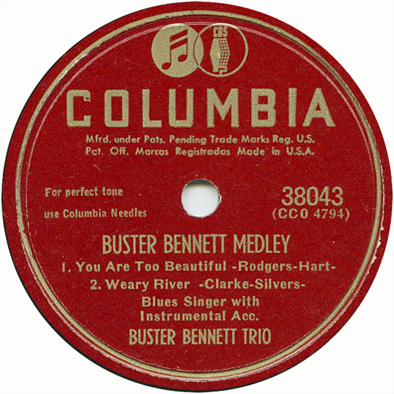
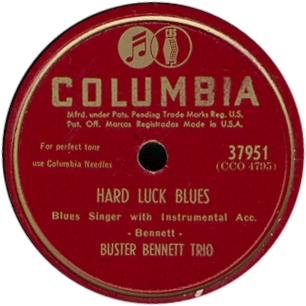
Columbia 37951, which used two sides from this session, was released in November 1947 (see Billboard, November 8, 1947, p. 33, for a listing). The Buster Benett Medley came out a few weeks later, on Columbia 38043 (listed in Billboard on December 27, 1947, p. 31). 30100 and 30106 were the numbers assigned to them in the company's "race" series; we've run into no evidence of any record labels with these numbers. 30148 (after Columbia took its blues and R&B singles out of the 35000 series in May 1948 and started releasing them all with "race" series numbers attached) was Columbia's last Buster Bennett single, listed in Billboard, December 18, 1948 (p. 34). It got a review of pronounced negativity (January 1, 1949, p. 89), which trashed "Rockin' My Blues Away."
Classics 5037, Buster Bennett 1945-1947, issued in June 2002, is the first comprehensive reissue of Buster Bennett's work as a leader. All 22 of his issued sides are included.
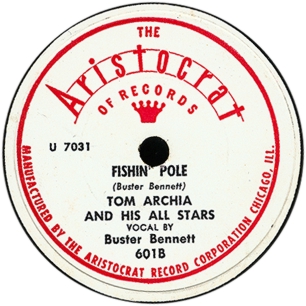
Tom Archia (ts); Buster Bennett (ts, voc); Bill Owens (p); Hurley Ramey (eg); Dallas Bartley (b); Jump Jackson (d); Sheba Griffin (voc); George Kirby (voc).
Universal Recording, Chicago, July 1947
| U 7028 | Mean and Evil Baby [Mean and Evil Daddy*] (Rudy Monroe) [SG voc] | Aristocrat 601A, Chess 1448*, Classics 5006 [CD] | |
| U 7029 | Ice Man Blues (George Kirby) [GK voc] | Aristocrat 602A, Chess CHD2-9387 [CD], Classics 5006 [CD] | |
| U 7030 | Cherry (Sheba Griffin) [SG voc] | Aristocrat 602B, Classics 5006 [CD] | |
| U 7031 | Fishin' Pole (Buster Bennett) [BB voc] | Aristocrat 601B, Chess CHD2-9387 [CD], Classics 5006 [CD] |
Aristocrat 601 and 602 were 78-rpm singles, released around November 1947 and February 1948 (according to White). Many thanks to collector Tom Kelly for providing label scans for these rare 78s. Chess 1448 was a 78 and 45-rpm single released in late 1950. Chess CHD2-9387, The Aristocrat of the Blues: The Best of Aristocrat is a 2-CD various artists collection from the Aristocrat label, released in August 1997. Classics 5006, Tom Archia 1947-1948, is a CD released in 2000.
Lord's treatment is highly incomplete. Even Ruppli's Chess discography does not specify the rhythm section; neither Lord nor Ruppli mentions the second tenor sax. The Chess CD gives the rhythm section listed here, which is identical to one that Jump Jackson used on U7018-U7023 for Aristocrat a month or so earlier. The guitarist does sound different from Leo Blevins, who worked with Archia later, and the pianist does not resemble either Bill Searcy or Willie Jones, who worked regularly with Archia later.
The second tenorist is not mentioned in any source. Previous speculation in these quarters pointed to Gene Ammons (the other tenorist plays too rough, however) and to Edddie "Sugarman" Penigar, who was on the Jump Jackson session with Tom Archia. But the vocal credit to Buster Bennett on "Fishin' Pole" (the vocals on this one number are accompanied by Tom Archia only) solves the mystery at last.
The vocalists have been grievously misidentified in previous sources, including the one CD reissue of some of these items. Sheba Griffin did sing on this session, as advertised. But the liner notes to Chess CHD2-9387 claim that she was the vocalist on the phallocentric "Fishin' Pole"!
Worse yet, the two male vocalists were never correctly identified. George Kirby (a comic, locally renowned for his impressions, who broke in at the Club DeLisa) is posted on the label as the vocalist on "Ice Man Blues." Buster Bennett is identified as the vocalist on "Fishin' Pole" and his singing is recognizable (in fact, we wonder whether this is same number as his unissued "Let's Go Fishin'"). Ruppli and others have attributed these vocals to Dr. Jo Jo Adams.
Buster Bennett has a distinct tenor sax solo on "Ice Man Blues." Otherwise, he and Tom Archia are mostly improvising simultaneously when Tom is not soloing. Buster's tenor work on this session is his best on record.
Buster's appearance here must not have been pleasing to senior management at Columbia. Unlike Sultan or Rhumboogie, Aristocrat had the temerity to put his name on the label...
Still another company decided to record a Buster Bennett group, but exercised greater discretion. So much discretion, in fact, that Buster's presence on the session credited to his bassist, Israel Crosby, went unreported for 63 years, and full session details are now on hand after 65.
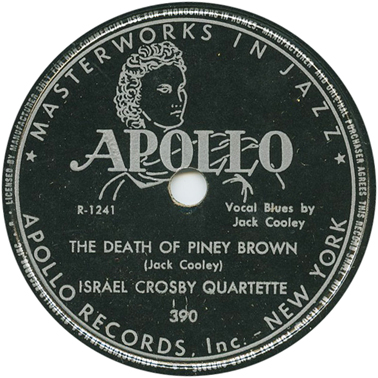
Israel Crosby (b); Buster Bennett (ss, voc on ^); unidentified (p); Jack Cooley (voc on *); Theodore Dudley "Red" Saunders (d).
Chicago, late 1946 or early 1947
| R-1240 | I Feel the Blues (Jack Cooley [sic]) | Apollo 405 | |
| R-1241 | The Death of Piney Brown (Jack Cooley) | Apollo 390 | |
| R-1244 | I Deal in Cats (Buster Bennett) | Apollo 405 | |
| R-1246 | I Know the Blues (Jack Cooley) | Apollo 390 |
Apollo 390 was a 78-rpm single released in September 1947 (see the listings in Billboard, September 20, 1947, p. 143). 390 was advertised by the Hot Platter Record Shop in the Cleveland Call and Post on December 20, 1947 (p. 7B). Apollo 405 was released in March 1949 (listed in Billboard on March 26, 1949, p. 35; the listing read "Ideal in Cats," but the original label reinforces the parsing that has appeared in discogaphies, "I Deal in Cats").
Israel Crosby was Buster's regular bassist during 1947. We hadn't previously associated Jack Cooley with Buster, who was mostly doing trio gigs in the clubs without a drummer. However, there is a further question whether Cooley was the drummer on this sesssion (or on how much of it). In the studio, Cooley did usually play the drums when he sang, but we suspect he was not on the traps for most of this outing (note the title of the track that Apollo didn't release, and the prominent drumming thereon). A close comparison between all of the drumming on this session and on some of Buster's acknowledged sessions for Columbia still needs doing. Meanwhile, Jack Cooley and Israel Crosby had worked together in Albert Ammons' groups during 1946, cutting three sessions for Mercury with the boogie pianist. Crosby was on most of the Albert Ammons sessions for Mercury, from 1945 through the end of 1947.
The previous year, Buster made an unannounced guest appearance on a Red Saunders session for Morton Sultan's short-lived label, singing and playing on a celebrity-roast blues, "Red, The Be-Bop Guy." The song itself wasn't bebop, but we know that Red and his band rather promptly learned to play bebop (as we can hear on two instrumental sides they cut for Supreme).
Buster's presence on these two Apollos was masked by using Jack Cooley as the vocalist (singing two numbers that Buster would otherwise have taken himself, singing on the unissued side, then assuming credit for a third vocal that Buster did take himself). Putting Israel Crosby down as the leader also had the desired effect (we hope it put $82.50 in Crosby's pocket). Identifying Buster as the composer of "I Deal in Cats" (the only instrumental) wasn't such a smart move, but in 1949 hardly anyone saw the label.
Even without the vocal turn, or the composer credit, one listen to the soprano saxophone work will tell the tale. Buster is all over each side, and the group sounds like one of his ensembles. Frank Driggs (writing for Delmark in 1996) thought the soprano sax on "Reboppin' for Red" was by Ben Smith, a saxophonist born in 1905 in the Southwest. But Driggs also thought only Sidney Bechet was the only black performer playing soprano sax in 1946 or 1947, which strongly suggests he'd never heard of Buster Bennett. Besides, the October 1946 session that Driggs thought "Reboppin'" came from included Apollo matrix number 1076, and that can't be right for this session.
Konrad Nowakowski has identified the soprano sax work on this session as the work of Edgar Saucier (1910-1962). Saucier, an excellent alto saxophonist, had been busy with the Melrose combine around the time that Buster started getting recording work, and remained on the Chicago scene well into World War II. In fact, a session by the Yas Yas Girl (9 sides from August 31, 1939) was once credited to Buster by Document Records, as well as by previous editions of this artist page. Some years back, J. C. Hillman convinced us that the alto saxophonist was Edgar Saucier; accordingly, see the Appendix.
Robert Campbell disagrees with the Saucier identification, for four reasons. First, are there are other recordings on which Edgar Saucier played soprano saxophone? (We have them from Buster.) Second, the attack and phrasing sound, to RLC's ears, like Buster's. Third, all parties recognize the vocal on "I Know the Blues" as Buster's, not Jack Cooley's (it really is Cooley on the other three vocal sides that we have); "I Know the Blues" is the only side on which the soprano sax does not accompany the vocalist; and "I Know the Blues" is only 1 minute 52 seconds in length. The soprano sax solo ends abruptly and so does the record, reminding us that Buster had been hospitalized with TB and sometimes had to cut back on the blowing. If R-1240 was also the first side recorded, the other blues vocals could been reassigned. Number four, by 1947 Buster Bennett, the gutbucket saxophonist, was working Charlie Parker runs into his solos. Did Edgar Saucier ever cop the bop? Did Ben Smith cop the bop? "Reboppin' for Red" seems to be commemorating another tune (see the Sultan session above), but musically it isn't a pose. "I Deal in Cats," the n+umpty millionth construction on top of "I Got Rhythm," quotes "Ornithology." Did Edgar Saucier ever quote "Ornithology"? The discerning listener will have no trouble locating other Bird licks on these sides.

We don't doubt that the session was made in Chicago. Studio and precise date remain a mystery, however, as does the company originally responsible for the recording.
It is highly unlikely that the session was originally done for Apollo, an East Coast outfit. Sessions for undercapitalized Chicago labels (see our JOB and Parkway pages) were often scavenged for release on New York area independents, such as Apollo and (later) Regal. Confirming the impression are the matrix numbers that Apollo settled on (each side of Apollo 390 and 405 has different numbers crossed out in the trail-off shellac; Konrad Nowakowski has shown that they were crossed out because someone at Apollo realized they'd been applied to a different session already).
The title never issued on Apollo, then misidentified by Delmark, gives us an idea as the original recording entity.
The, ummm, paucity of documentation on Morton Sultan's' label makes this paragraph conjectural However, we know that Sultan recorded (and once intended to release) a fourth jazz session in Chicago, by Chet Roble's trio featuring Boyce Brown. Could he have attempted a fifth session, with the personnel listed above? Sultan had already recorded Red Saunders and Buster Bennett, and the rest of the crew would have come recommended, either by Buster himself or by his regular bassist. The difference would then be that Morton Sultan couldn't find a buyer for the Chet Roble session (so far as we know it's been lost), but he was able to unload this one to the Bermans at Apollo because it had R&B potential. (We know that after his label and his distributorship ran out of money, Sultan did sell off all or part of the Jewish cantor singles he had recorded.) Of course, recording by Sultan and subsequent acquisition by Apollo could have interposed months of delay between the recording date and the date that Apollo put one set of master numbers on the items, then crossed them out and replaced them. (We are also still wondering who played piano, which might give us a further clue.)
Fancourt and McGrath say there is a tenor saxophone on the date. They didn't hear anything from it.
A larger ad for the Tradesmen's Club, on July 26, 1947, promoted Chuck Johnson's All-Star Review, which included "Buster Leap Frog Bennett and his recording band," along with Mitzi Mars, Dorothy Bryant, Connie Morrow, and the usual dancers. On August 21, "Jos Buster Bennett"'s contract for 8 more weeks at the Tradesmen's was accepted and filed at Local 208. By October, Bennett ended his run at the Tradesmen's and Dick Davis's band was now in. Just in time, as it turns out. On November 1, Matt Lightfoot emptied out the cash register and took off, leaving his nephews Harold and Ralph in charge of the club, which appears to have folded later in November.

Buster Bennett picked up in October 1947 by working the off-night at the Circle Inn and doing 4 nights a week at Club Maramba, a West-side establishment that hired saxophone-playing leaders (both contracts were listed in the Local 208 Board minutes for October 16). As the end of the year approached, Bennett was once again in the employ of Macey McOneal, at a new joint. A Defenderad for McOneal Famous Door, 31st and Cottage Grove, ran on December 20, 1947. Buster Leap Frog Bennett, Jenny Dell, and Bill Weavers were featured at the Sunday afternoon dance starting at 4 p.m. On December 27, the Defender promoted a "New Years Party at the Famous Door / Starring / The inimitable Buster Bennett and his Orchestra." The Famous Door contract, which appeared on the Local 208 list on December 18, was for 4 weeks with options.
Buster Bennett (ts, as, voc); Fortunatus Paul "Fip" Ricard (tp); Andrew "Goon" Gardner (as); Wild Bill Davis (p); Israel Crosby (b); unidentified (d).
Columbia Studios, Chicago, December 30, 1947
| CCO 4990 | Famous Door Boogie (Bennett) | Columbia 38173, "Columbia 30116," Classics 5037 [CD] | |
| CCO 4991 | Play Those Riffs (B. Bennett-Bill Davis) [BB, ens voc] | Columbia 30132, Classics 5037 [CD] | |
| CCO 4992 | Three Different Women (Bennett) [BB voc] | Columbia 38173, "Columbia 30116," Classics 5037 [CD] | |
| CCO 4993 | Stop That Walking Baby (Bennett) [BB voc] | Columbia 30132, Classics 5037 [CD] |
Buster continues to play tenor sax on this session. His solo space is notably cut back, raising concerns about diminished lung power. There is no solo at all on the last item from the session, "Stop That Walking" (which makes it his only such record as a leader), and his excursions are kept on a short leash on the second and third sides—maybe he tired himself out with "Famous Door Boogie." Said boogie, named after his current club, is a blatant ripoff of "Time Out," from the Count Basie band book; it could be that a tribute to a more famous Famous Door was simultaneously intended.
Columbia 38173 reached the stores in April 1948 (listed in Billboard on April 17, 1948, p. 121); it was given the bookkeeping number 30116 in the "race" series. This was about to become a real series, at Columbia 30125, but so far as we know no 78s went out the factory door with 30116 on their labels. The first Columbia 78 with a 30000-series number on the label was 30120 by Memphis Minnie, listed in Billboard on May 15, 1948. Buster's Columbia 30132 was released under the new policy, and listed in Billboard on July 17, 1948 (p. 31). Two weeks later, Billboard panned it (July 31, 1948, p. 167)
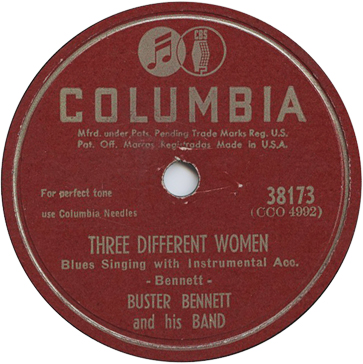
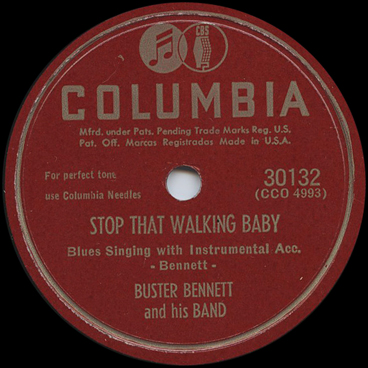
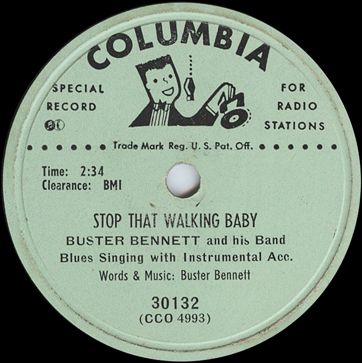
Classics 5037, Buster Bennett 1945-1947, issued in June 2002, is the first comprehensive reissue of Buster Bennett's work as a leader. 22 sides—everything issued under his name, plus the 2 Charles Grays—are included.
The trumpeter on this session is an exciting player—a bopper with substantial Eldridge influence. No reason to question the presence of a young Fip Ricard here (Fip was in Buster's band at the Famous Door). The alto soloist has a somewhat astringent tone and is heavily into Bird. Who else but Bird's onetime section mate with King Kolax at the 65 Club, Goon Gardner? Buster sneaks in a brief alto solo after his brief tenor solo on "Play Those Riffs."
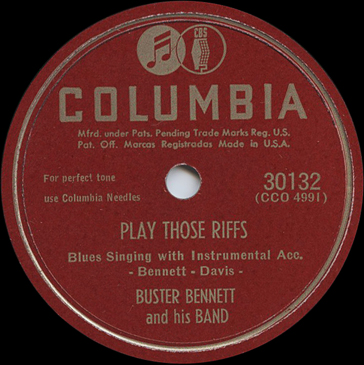

"Play Those Riffs" is co-credited to Bill Davis. Wild Bill left the Louis Jordan band in October or November 1947; he was replaced by Bill Doggett when Jordan recorded in November. (His replacement was supposed to be Marl Young, but Young arrived in Los Angeles only to discover that Jordan had gone ahead and recorded without him, and was perfectly content to retain Doggett's services. See our Sunbeam page for more of this story.) Davis would work as a leader for much of the next year, joining forces with Claude McLin in October and November 1948; we are not sure what he was doing after that, but he appeared on a recording session in February 1949 (see our Sax Mallard page for that one), took one last gig in Chicago in October 1949, then moved to a long-term engagement at Small's Paradise in Harlem (see the Wild Bill Davis interview in Cadence, September 1988, p. 23).
We once thought that the drummer on this session was Jimmy Crawford, who was reported to be working with Buster a week or two later. However, Tom Lord's Jazz Discography has Crawford in New York City on December 30, 1947, backing Punch Miller on a Century recording session.
After 38173 (which was issued at some point in 1948), Columbia management quit running two sets of numbers for its "race" releases. Most of the 78s with dual catalogue numbers, after Columbia shut down OKeh, are known strictly with 38000 series numbers, and copies found with 30000 numbers may be later pressings. Buster's last two releases appeared in the designated "race" series only. Previous discographies have listed "Play Those Riffs" and "Stop That Walking Baby" as appearing on a Columbia 38132, but this is a misprint for 30132. The real Columbia 38132 was a country single by Bob Atcher.
Buster and his combo were starting to encounter slack periods, which they sought to fill by taking one-nighters. On March 13, 1948 Buster played a dance for the Industrial Entertainment Corporation; falling back on his old modus operandi, he asked for another $63, promising to treat it as a deposit against another dance engagement. But Buster was in Cleveland by the time that IEC sought his services again; the company would be unsuccessful in its attempts to collect from him until August 2, 1951. On May 29, 1948, Buster took a Saturday night engagement at the CIO Hall in Harvey, Illinois, substituting for Sir Oliver Bibbs, who had contracted the job but had since picked up steady work elsewhere. Buster brought a four-piece band to the gig, including Robert Montgomery on piano. The promoter, Mr. Christiana, failed to pay him. The Board found that Bibbs owed Bennett $73 plus $10 for carfare to the gig and asked Bibbs, in turn, to file a claim against the promoter. Buster was able to cut a deal with Sir Oliver, then neglected to include his band members:
It was disclosed that Bennett and Bibbs made a mutual agreement to settle Bennett's claim for $40.00, plus a soprana saxaphone [sic]. Bennett was asked if he paid his side men, and his replay [sic] was "no". He stated that he had not paid the men because it was his understanding that the money should be paid as of today. He was instructed to go home and get the money....
Within a few minutes Bennett brought the $40.00 to the Local, which was $2.00 less than the wage scale [for his three sidemen]. However, this amount was included in the price of the saxaphone [sic], so he paid the $2.00. (Local 208 Board minutes, June 17, 1948, pp. 1-2)
There was a further spot of trouble around this same time when Buster borrowed a Conn saxophone from Warren Smith; the borrowed horn was stolen from the Vincennes Hotel, and he failed to compensate Smith for the loss.
In mid-June, tenor saxophonist Dick Davis and his combo took over for Buster at the Club Algiers (Davis's contract was posted on June 17). Buster, in turn, had accepted an offer from a club in Cleveland, Ohio (which, we know from other sources, was none other than the Tia Juana, address variously given at 10511 Massie Avenue or 1045 East 105th). This led to more excitement at the already eventful Local 208 Board meeting of June 17:
Members Buster Bennett, Robert Montgomery and James Bolden appeared before the Board, at Bennett's request. Bennett stated he had accepted a two week engagement in Cleveland, Ohio and had mailed the contract to Local #550, to open June 24th. He further stated that after he had gone this far the men refused to go, which placed him in the predicament of not having an organized orchestra, and would require the rehearsal of new men.
Montgomery stated that he didn't want to go to Cleveland because Bennett argues too much, and he did not care for the confusion and embarrassment. He stated that on every job he had played with Bennett, for the past three years, that this unpleasant condition prevailed. Bolden's reasons were the same.
They were asked to think the matter over, and go, if possible.
Did Montgomery and Bolden go? At least Montgomery continued to work for Buster later on. However, George Peters, a pianist originally out of Roanoke, Virginia, reportedly came to Cleveland with a Buster Bennett unit. Peters, who was definitely working with Buster in 1949 (see below), stayed in town and became part of the local scene, most often as the leader of his own quartet; Peters died in Cleveland on July 18, 1970 ("Noted Musician Dies Suddenly," Cleveland Call and Post, July 25, 1970, p. 1A). Buster proved a hit at the Tia Juana, where he was held over for two weeks. He became interested in establishing himself in Cleveland, which would be his home base for most of the next two years.
There were a few road trips out of his new base. After his arrival in Chicago, Buster seems to have avoided performing in the South. But in November he was spotted down in Rocky Mount, North Carolina, where he did a one-nighter at the Negro Community Center to raise money for the city recreation fund ("Buster Bennett to Play Here Friday," The Evening Telegraph [Rocky Mount, NC], November 10, 1948, p. 6-B).
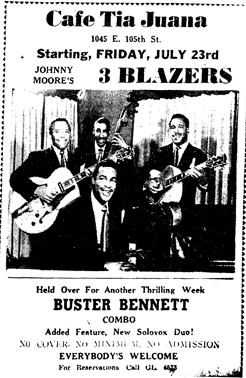
It was during his return engagement at the Tia Juana (coyly referred to, in the piece, by the streets that bounded it and the two closest bus stops—maybe this was the Call and Post's way of urgently requesting more display ads?), in August 1949, that Bennett was featured as a "Cafe Personality" in Bob Williams' nightlife column "Bobbing Along." This was a vivid portrayal of Buster Bennett in full hustle. It turns out, for instance, that Buster was in the habit of claiming he'd written "You Are Too Beautiful":
BUSTER BENNETT, whom the girls carelessly call Mr. Ben-net, with a French accent on the last syllable, and not at all displeasing to Buster, is, perhaps, the most flamboyant of all local or localized entertainers...
Buster […] has become as thoroughly integrated and as much a part of community social life as if he had come out of Central High School a few years ago.
La [sic] Bennett is one of those guys you don't necessarily care to like but you end up, invariably, in his corner, every time ... he grows on you like an octopus ... one of those delightful rascals who can practically insult you with a grin on his face and make you feel that he is harmless, which, as a matter of fact, he is ....
He's not much to look at but has a disarming way with the ladies as well as with men, a sort of people's choice candidate, you know ... he can sling a pretty heavy ball in almost any crowd and this is only one of his many talents...
Buster is a talented musician, a saxophone player by professional rating and a band leader, but in addition he sings in a soothing, sentimental voice which remains tangy for all of its whisky flavor, and if you catch him in private, he can play the piano as well as arrange music...
[…]
"YOU ARE SO BEAUTIFUL" must have been written as an instrument of personal as well as professional progress, for it is the song he has promised would come out on sheet music for, lo, these two longs years at least, and every glamour girl around E. 105th Street corners has been promised that SHE was the "perfect type" of beauty to grace the cover of such a song sheet... […] (August 6, 1949, p. 8B)
Other gigs that Buster picked up in Cleveland included a hairstyle show at the Mercury Lounge on September 25, 1949 (Call and Post, September 24, 1949, p. 13B) and a gig at Club Venice, Carnegie Avenue and East 100th, where he was broadcast live on September 25 by WSRS radio. On the same broadcast was up-and-coming singer Terry Timmons. At the time, Buster was working with a quartet whose other members were George Peters, piano; William Gringe, bass; and Fats Heard, drums (Bob Williams, "Bobbing Along," Cleveland Call and Post, October 1, 1949, p. 8B). On February 13, 1950, Buster's combo played the Hearts and Flowers Valentine's dance for teenagers at the Friendly Inn, to raise money for Charity Hospital (Cleveland Call and Post, February 18, 1950, p. 13A).
There are no Defender ads for Buster in 1949 or 1950; he also disappears from the minutes of the Local 208 Board. Buster was in Cleveland for most of this time, under the watchful eye of Local 550. But drummer Vernel Fournier recalled his service in Buster's band, working in and around Chicago, as extending from October 1950 (when the Macomba Lounge closed) into early 1951. According to Fournier, Buster was playing nothing but tenor sax at the time. The band had instrumentals in the book (including "Leap Frog," which Buster often used to open sets) but Fournier remembered Buster singing standards, not blues. Which is consistent with Bob Williams' description of Buster in Cleveland. Working alongside Duke Groner (who sang a lot of ballads) from 1943 to 1945 might have rubbed off on Buster.
On June 9, 1951, the Defender ran an ad for the New Cotton Club at 6249 Cottage Grove; the artists were the Red Simms Combo and Buster (Leap Frog) Bennett. The next week Buster had top billing and "Red Sims Combo" appeared in smaller print. Now that Buster was working in town again, his creditors were able to catch up. On August 2, the Board of Local 208 found Buster liable for $63 to Bernard Hinton of Industrial Entertainment Corporation (for the dance engagement he had contracted to do back in 1948 and never fulfilled); he was also ordered to pay Warren Smith $125 for the saxophone he had borrowed and failed to return. He did not pay the claims within 10 days, as ordered, and on August 16, now "erased," he had to tell the Board that he was unemployed, but would pay both claims once he collected unemployment compensation. The Board also pressed him for failing to pay "surcharge tax" to the National office for an engagement he had recently played at the Lush Head Lounge in Rockford, Illinois.
Meanwhile, "Buster Bennett and His Entertaining Musicals," "Direct from Chicago's Cotton Club" (for once an ad was truthful about the band's previous engagement), went on an excursion to Detroit to open a new program at the Crystal Show Bar (Detroit Free Press, July 2, 1951, p. 12).
Buster must have worked out some deal with the Union, because he was able to return to work in another two weeks. An ad for the Cork Club (practically next door to the New Cotton Club at 6239 Cottage Grove) covering August 31 through September 2 urges readers to "Leap on Down and hear 'Leap Frog'"; the band was billed as Buster (Leap Frog) Bennett and his Columbia Recording Band, and Buster's picture was deemed worthy of inclusion. Defender ads show that Buster was still holding forth at the Cork Club on September 29 and October 20, 1951. On October 4, the Local 208 Board accepted and filed three contracts between Buster and the club: two for 3 days each and a third for an indefinite period.
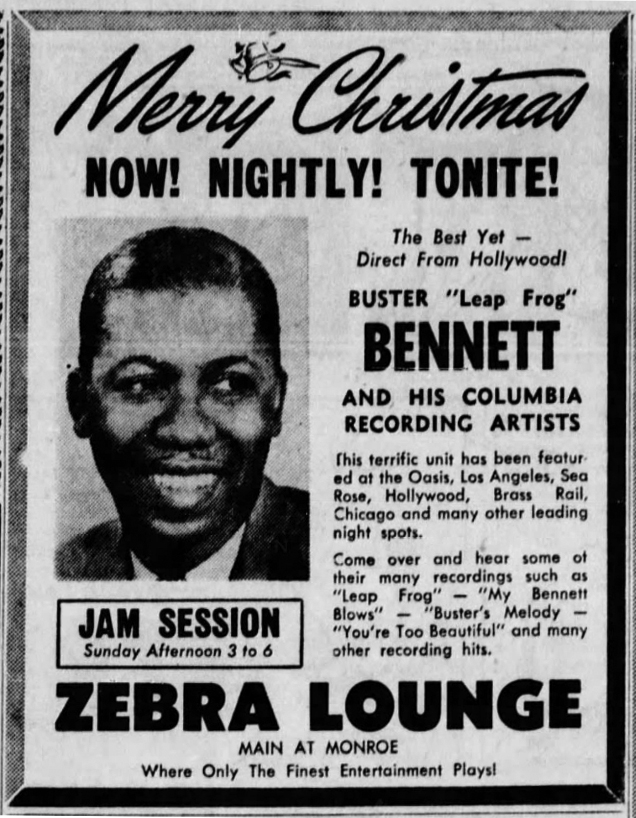
Bennett spent the Christmas season in Green Bay, Wisconsin, where his band was featured at the Zebra Lounge. Folks in Green Bay had no idea how many years back his Columbia sides went, so several were mentioned. Buster was said to be "Direct from Hollywood!"—specifically from the Oasis in LA and Sea Rose in Hollywood. This is the first reference we've seen to any West Coast appearances, so it would be nice to be able to verify them (Green Bay Press-Gazette, December 21, 1951, p. 19). The Zebra Lounge ad also carries the latest photo of Buster that we have seen anywhere.
An ad for the 2600 Club, January 16, 1952, mentions Buster (Leap Frog) Bennett and his Combo. After that he was in and out of town again. On June 5, however, he posted a contract with Local 208 for 3 months at the Pershing Lounge. On June 19, 1952, while working the Pershing Lounge gig, he was called in front of the Local 208 Board once again because of a beef with his drummer, Wilbur Campbell.
Bennett stated that he learned Campbell was using narcotics during an out-of-town engagement when Campbell played with him, and he gave him a verbal notice before they started the Pershing Lounge engagement that if he continued using narcotics on the job he would be dismissed immediately. Bennett further added that Campbell went to sleep every night on the band stand.
The Board applied a strict standard to such cases: to be able to fire him for using without giving two weeks' notice, Bennett would have had to catch Wilbur Campbell shooting up (Campbell, who had undergone the "dope cure" in Lexington, Kentucky, claimed to have kicked the habit). Since Buster hadn't met the standard of proof, and had hurt his case by "conveniently" trying to let Campbell go on a payday, the board ruled that Bennett must either keep Wilbur Campbell for another two weeks or pay him two weeks' salary immediately. Given Buster's financial condition, he had to keep Wilbur Campbell on the job, whatever the effect on bandstand relations. On July 3, 1952, he tried to reopen the case before the Board, to no avail.
In any case, the Pershing's management was satisfied, because on July 3, Buster posted a contract for 4 more weeks. In August he moved to some old haunts at the Circle Lounge (2 week contract with option, posted on August 7.) On September 4, his contract for 2 weeks at the Fifth Avenue Lounge was accepted and filed.
From October 26 through December 28, 1952, Buster and his quartet (Robert Montgomery, piano; William Lee, bass; and Chuck Williams, drums—Bill Lee is the father of Spike Lee, the film director) worked 4 nights a week at Club Evergreen (their contract for 2 weeks plus option was posted on November 6). On January 8, 1953, the entire band appeared in front of the Local 208 Board because Henry Gioe, who owned the club, had stopped paying Buster his leader's fee after three weeks on the job, and had withheld the final week's wages from all four players. The Board ordered Gioe to pay back wages to Montgomery, who had run up no bar tab, and Williams and Lee, who had run up modest tabs. Buster, who had already obtained advances on his salary from Gioe, and had run up a bar tab of $95.15 against a weekly salary of $200, got nothing. The Board further noted that Buster had failed to pay the "Local tax" on his engagement. He was ordered to cough up by the the end of his next out-of-town engagement or "stand erased."
On January 10, 1953, Buster's quartet (with Montgomery, Lee, and Williams) opened at the Chesterfield Club in Sioux City, Iowa (a gig obtained by the Central Booking Agency). Their low-paying engagement lasted at least two weeks (there was an option to extend it to four, but we don't know whether that was taken). As of April 16, 1953, Buster had still not paid his delinquent "local tax," because on that date he appeared before the Board asking them to assume a note from a personal loan he had made to Robert Montgomery. The Board declined to do so, leaving Buster still $295 in arrears to Local 208.
Buster resurfaced as a leader in Chicago in early June (his contract with Club Gayety for 2 weeks, with options, was posted on June 4). A July 16, 1953 Defender ad put Bennett at the Savannah Club; the band was billed as "Buster Bennett and His Leap Frog Boys." In early August, Buster got a week at the Blue Note (contract posted on August 6). On October 29, 1953 the Club Gayety (629 East 47th) ran a Defender ad proclaiming that "The Man Is Back: Buster Leap Frog Bennett and his trio featuring Janet Leigh, Vocalist." Buster's last advertised appearance in Chicago took place on November 28, 1953. An item in the Defender of November 19 announced a big show upcoming at the Regal Theater, the "McKie Fitzhugh Variety Show of '54." On the bill were Ben Webster, Charlie Parker, the Edward Sisters, and T-Bone Walker (all featured with photos). Underneath these headliners, in smaller letters and without a photo were "Buster Bennett and His Band" (displayed in the spot often reserved for the house band). At the bottom of the ad were listed Dr. Jo Jo Adams, Dot and Dash, Muddy Waters, Sammy Rogers, and Eddie Boyd. Two shows were scheduled for November 28, from 8 to 12 midnight. DJ and music business entrepreneur Al Benson served as the MC and admission was $1.75; it would appear that the patrons got their money's worth!
We have turned up one last mention of Buster Bennett in Chicago. In April 1954, his trio was playing at the Sutherland Hotel Lounge. Although it would become a prime jazz venue in the 1959-1961 period, in 1954 the Sutherland couldn't afford display ads in the Defender. However, some promotional consideration must have been provided when the paper ran a blurb on April 3, 1954, under the title "'Buster' Bennett to 'Jam' for Fight Fans":
Buster Bennett and his ace trio, currently featured at Sutherland hotel will stage a special jam session Friday night for the benefit of fight fans who like swing-wine and dine fun after leaving the stadium.
For this occasion Bennett has arranged a special program with some of his recent song recordings featured. He will also put on display some of the new men he has signed for his combo. (p. 25)
Buster's newest recording was more than 6 years old.
There are no contracts listed for Buster Bennett in the Local 208 Board minutes for 1954, 1955, or 1956. He kept his dues up for a while, but on October 4, 1956, his name was mentioned for the last time: Joseph "Buster" Bennett was on a list of members ruled "erased" on a motion, because they had not paid up their accounts. According to the late Charles Walton, Buster was suffering from health problems that required him to quit playing professionally, and he ended up leaving town for good. We have seen that Buster had been in recurrent financial trouble ever since his recording contract ran out, and in the early 1950s he was often scuffling for work. There are gaps in the record, when he may have been sidelined by ill health, and on top of all that he was drinking heavily, if his bar tab at Club Evergreen is any indication. He moved to Texas, where he had been performing back in 1930.
Joseph Buster Bennett died in Houston on July 3, 1980. By then he was long retired from music. The Houston newspapers did nothing to commemorate his passing—no obituary, no notice in "area deaths." His later years remain a complete blank to us.
Buster's old associate Wild Bill Davis died in Moorestown, New Jersey, on August 17, 1995. While Buster was dropping out of music, Davis (who had switched to organ during his 1947-1949 stay in Chicago) was touring with a successful trio; in 1953, Floyd Smith left Chicago, which had been his own home base for several years, to play guitar in Davis's trio. Wild Bill Davis's later travels included successful collaborations with Johnny Hodges, leading to a stint as second keyboardist and arranger in the Duke Ellington Orchestra after the death of Billy Strayhorn.
Buster Bennett's recordings as a leader add up to 26 sides, decently recorded by the standards of the period. We are proud to announce that the 22 issued sides on Columbia (18 never reissued before) were finally released on CD, in very nice sound, on Classics 5037, Buster Bennett 1945-1947. Sony/Columbia (which could probably add four unissued sides, and do even better with the sonics) has missed a bet!
Buster was an effective blues shouter, and a distinctive stylist on soprano, alto, and tenor saxophone. Little attention has been given to his influence on other tenor saxophonists, but Red Holloway has said that he admired Buster Bennett as a youngster and copped a lot of licks from him. On his only recording session in the tenor-battle genre, with Tom Archia, Buster holds his end up admirably. Buster's rhythm section was tight-knit and distinctive, and his front-line partners among the best that Chicago had to offer. For those of us who weren't there, his Columbia, Rhumboogie, and Apollo recordings, plus his cameo appearance on Sultan, give us a reasonable understanding of Buster's ability to pull them in at the Tradesmen's Lounge.
Our heartfelt thanks to the late Otto Flückiger, without whose extensive files and collection of 78s we would have made no progress beyond previous sources, and to Victor Pearlin and Daniel Gugolz, whose record collections and tape dubbing enabled us to fill most of the remaining gaps. Thanks to Howard Rye, Görgen Antonsson, and Michel Chaigne for several further corrections; to the late Charles Walton for confirming that a "vendor" meant a jukebox in 1945; and to Joseph Scott for information about the Hoy Hoy reissue and Stash re-reissue of "I Want to Woogie Woogie," and the Indigo reissue of "Jersey Cow Bounce." Dave Weiner and Morgan Wright, in the notes to the Stash package, were the first to point us to Buster's given name. Joseph Scott has also traced Jimmy Crawford's movements, making it clear that he could not have been on any of Buster's recording sessions. The late Eric LeBlanc was tireless in tracking down persons named Joseph or Buster Bennett. Robin Kelly Cox, whose grandfather was Gilbert "Little" Mike McKendrick, helped us correct our confusion between Little Mike and Reuben "Big Mike" McKendrick; it was Big Mike who led the ill-fated trio at the 411 Club in 1942. The Local 208 minutes, preserved in the music collection of the Chicago Public Library, have added a tremendous amount of detail to our portrait of Buster. Articles in the Cleveland Call and Post give us some sense of Buster's forays there. But there is more to be done...
Extra special thanks to Steven Abrams and Tyrone Settlemier for their massive online documentation of the output of American Columbia (http://settlet.fateback.com). Their Web page introduced us to Columbia's use (between 1945 and 1948) of two sets of release numbers.


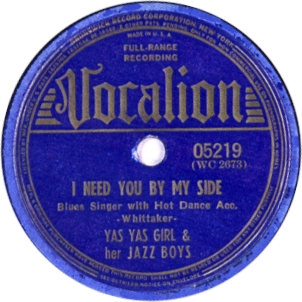
The Yas Yas Girl [Merline Johnson] (voc); Lee Collins (tp); Edgar Saucier (as); Blind John Davis (p); Alfred Elkins (imitation b).
Columbia Studios, Chicago, August 31, 1939
| WC 2671-A | Fine and Mellow (Holiday) | Vocalion 05105, Collector's Items 009, Document DOCD 5293 | |
| WC 2672-A | Nobody Knows How I Feel (Whittaker) | Vocalion 05105, Collector's Items 009, Document DOCD 5293 | |
| WC 2673-A | I Need You by My Side (Whittaker) ^ | Vocalion 05219, Document DLP 562, Document DOCD 5293 | |
| WC 2674-A | You Can't Have None of That* | Vocalion 05180, Columbia 37786, Columbia 30088, Document DLP 562, Document DOCD 5293 | |
| WC 2675-A | I Got to Have It, Daddy | Vocalion 05286, Columbia 37685, Columbia 30062, Document DLP 562, Document DOCD 5293 | |
| WC 2676-A | Don't Have to Sing the Blues (unknown) ^ | Vocalion 05219, Collector's Items 009, Document DOCD 5293 | |
| WC 2677-A | You're a Pain in the Neck to Me | Vocalion 05501, Conqueror 9449, Collector's Items 009, Document DOCD 5294 | |
| WC 2678-A | I'd Rather Be Drunk (Casey Bill Weldon)* | Vocalion 05180, Columbia 37786, Columbia 30088, Document DLP 562, Document DOCD 5294 | |
| WC 2679-A | I Just Keep on Drinking | Vocalion 05286, Columbia 37685, Columbia 30062, Document DLP 562, Document DOCD 5294 |
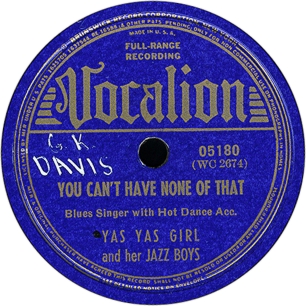


Our basic session information comes out of Lord's Jazz Discography. The Document liner notes put Buster Bennett on the alto sax, Big Bill Broonzy on guitar (when none is present), and suggest Blind John Davis as another possibility at the piano, instead of Joshua Altheimer. Meanwhile, Big Bill told André Vasset (see his book Black Brother, p. 145) that Blind John Davis was on this date (our thanks to Michel Chaigne for this reference). J. C. Hillman, who wrote liner notes to Collector's Items 009, argues (email of February 20, 2006) that Edgar Saucier is the alto saxophonist on this date, on account of lighter tone and phrasing than one normally hears from Buster Bennett. Saucier was also working in Lee Collins' band at the Derby Club around this time. A comparison with the alto sax work on Merline Johnson's session of February 10, 1939 shows that the alto saxophonist here, though working in a basically 1920s style, plays more softly and articulates less firmly than Buster was accustomed to. In fact, the saxophonist is deferential to Lee Collins, remaining in the background on the first two tracks, and only gradually stepping toward the microphone (coming through most strongly on the last three sides).
Alfred Elkins is responsible for the vocal imitations of a string bass. His role is crucial, in the absence of drums or rhythm guitar.
The Vocalion 78s were released at the time, as was their cognate on Conqueror 9449. Columbia 37685 and 37786 were 78-rpm reissues from 1947; Columbia 30062 was the counterpart of 37685 in the label's "race" series, and 30088 was 37786's doppelgänger. Collector's Items 009 was a British LP, titled Lee Collins in the 30s: I Can Dish It—Can You Take It?; it was released in 1982 (our thanks to John Holley, the proprietor of Collectors Items, for details). Document DLP 562 was a 1980s LP, probably a "remaining takes" collection. Document DOCD 5293 is a 1995 release from the Austrian historical blues label, The Yas Yas Girl Volume 2 (1938-1939). Document DOCD 5294 is another 1995 release, The Yas Yas Girl Volume 3.
Click here to Return to Red Saunders Research Foundation page.
Click here to Return to Robert Campbell's Home page.